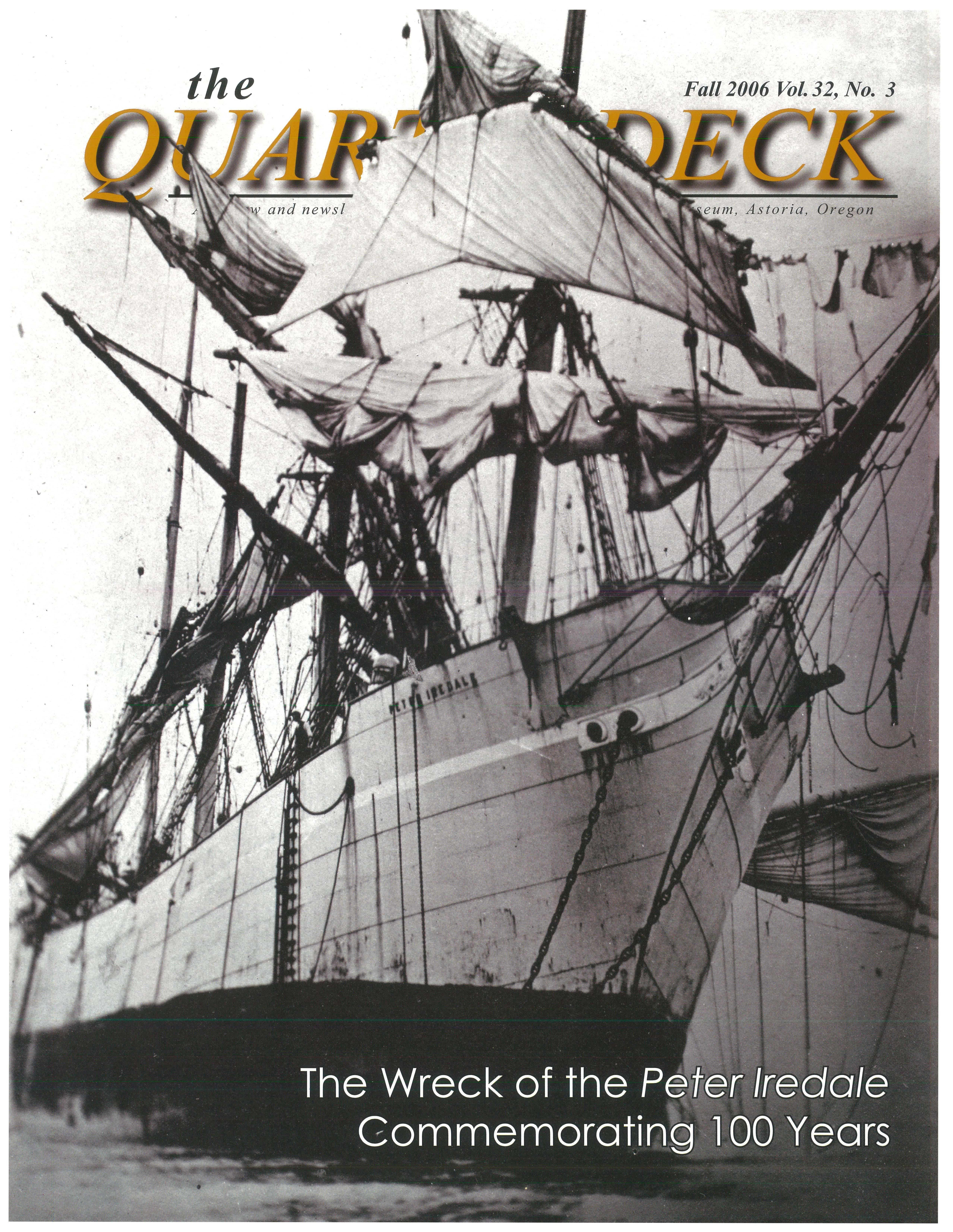
Afterguard
Donald Magnusen , Chairman
Thomas V. Dulcich, Vice Chairman
Prudence M. Miller, Secretary
Capt. Rod Leland, Immediate Past President Ward Cook, Treasurer
W. Louis Larson , Advisor
Shelley Wendt , Advisor Cheri Folk , Advisor
Jerry L. Ostermiller, President
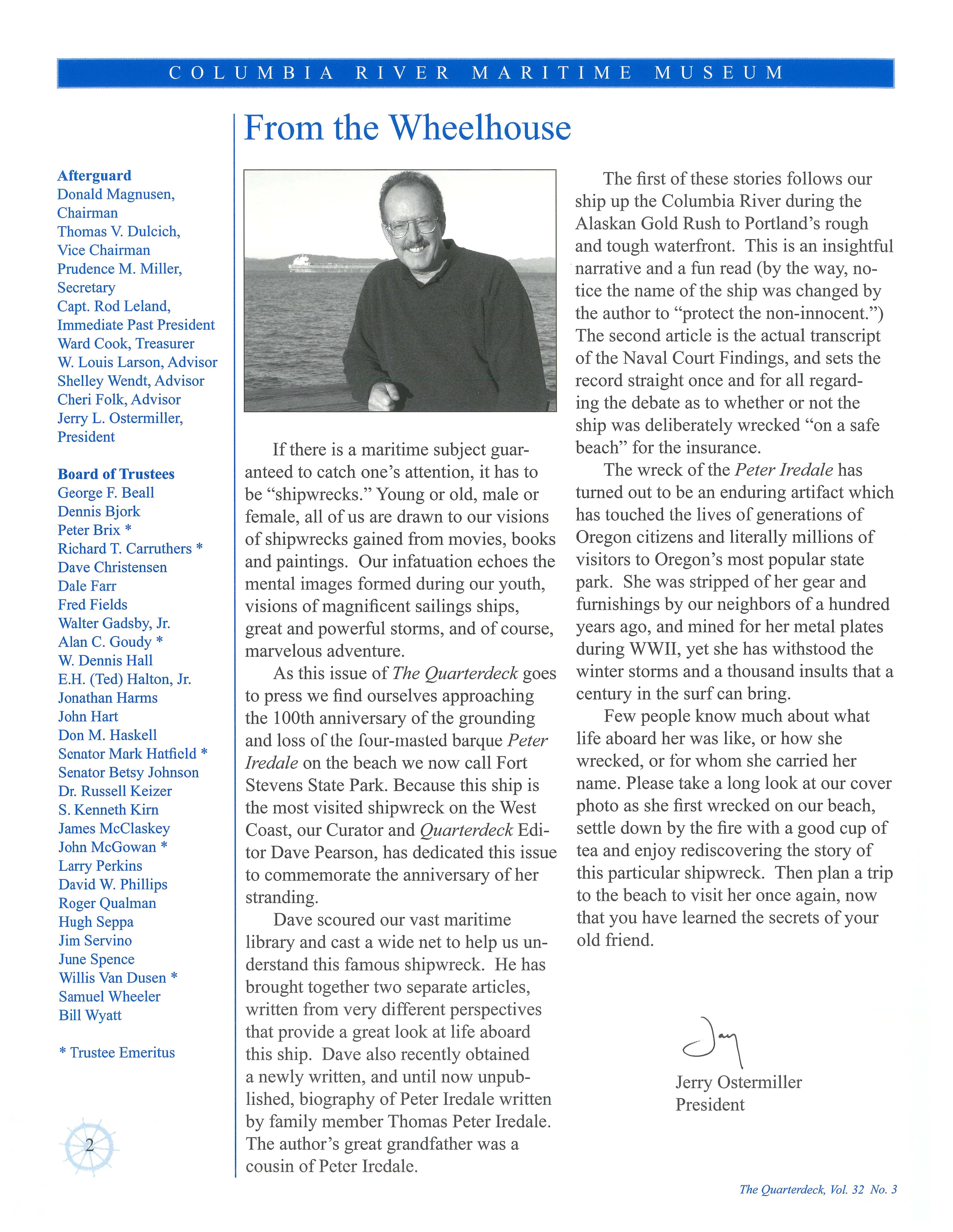
Board of Trustees
George F. Beall
Dennis Bjork
Peter Brix*
Richard T. Carruthers * Dave Christensen
Dale Farr
Fred Fields
Walter Gadsby, Jr. Alan C. Goudy *
W. Dennis Hall
E H. (Ted) Halton , Jr Jonathan Harms
John Hart
Don M Haskell
Senator Mark Hatfield *
Senator Betsy Johnson
Dr Russell Keizer
S Kenneth Kim
James Mcclaskey
John McGowan *
Larry Perkins
David W. Phillips
Roger Qualman
Hugh Seppa
J im Servino
June Spence
Willis Van Dusen *
Samuel Wheeler
Bill Wyatt
* Trustee Emer itus
From the Wheelhouse
Ifthere is a maritime subject guaranteed to catch one's attention, it has to be "shipwrecks." Young or old, male or female, all of us are drawn to our visions of shipwrecks gained from movies, books and paintings. Our infatuation echoes the mental images formed during our youth, visions of magnificent sailings ships, great and powerful storms, and of course, marvelous adventure.
As this issue of The Quarterdeck goes to press we find ourselves approaching the 100th anniversary of the grounding and loss of the four-masted barque Peter Iredale on the beach we now call Fort Stevens State Park. Because this ship is the most visited shipwreck on the West Coast, our Curator and Quarterdeck Editor Dave Pearson, has dedicated this issue to commemorate the anniversary of her stranding.
Dave scoured our vast maritime library and cast a wide net to help us understand this famous shipwreck. He has brought together two separate articles, written from very different perspectives that provide a great look at life aboard this ship. Dave also recently obtained a newly written, and until now unpublished, biography of Peter Iredale written by family member Thomas Peter Iredale. The author's great grandfather was a cousin of Peter Iredale .
The first of these stories follows our ship up the Columbia River during the Alaskan Gold Rush to Portland's rough and tough waterfront. This is an insightful narrative and a fun read (by the way, notice the name of the ship was changed by the author to "protect the non-innocent.") The second article is the actual transcript of the Naval Court Findings, and sets the record straight once and for all regarding the debate as to whether or not the ship was deliberately wrecked "on a safe beach" for the insurance.
The wreck of the Peter Iredale has turned out to be an enduring artifact which has touched the lives of generations of Oregon citizens and literally millions of visitors to Oregon's most popular state park. She was stripped of her gear and furnishings by our neighbors of a hundred years ago, and mined for her metal plates during WWII, yet she has withstood the winter storms and a thousand insults that a century in the surf can bring.
Few people know much about what life aboard her was like, or how she wrecked, or for whom she carried her name. Please take a long look at our cover photo as she first wrecked on our beach, settle down by the fire with a good cup of tea and enjoy rediscovering the story of this particular shipwreck. Then plan a trip to the beach to visit her once again, now that you have learned the secrets of your old friend .
Jerry Ostermiller President
--~-----COLUMBIA RIVER MARITIME MUSEUM -~
2
Th e Qu art erdec k, Vol 32 No. 3
A Remarkable Voyage on the Pete r I redale
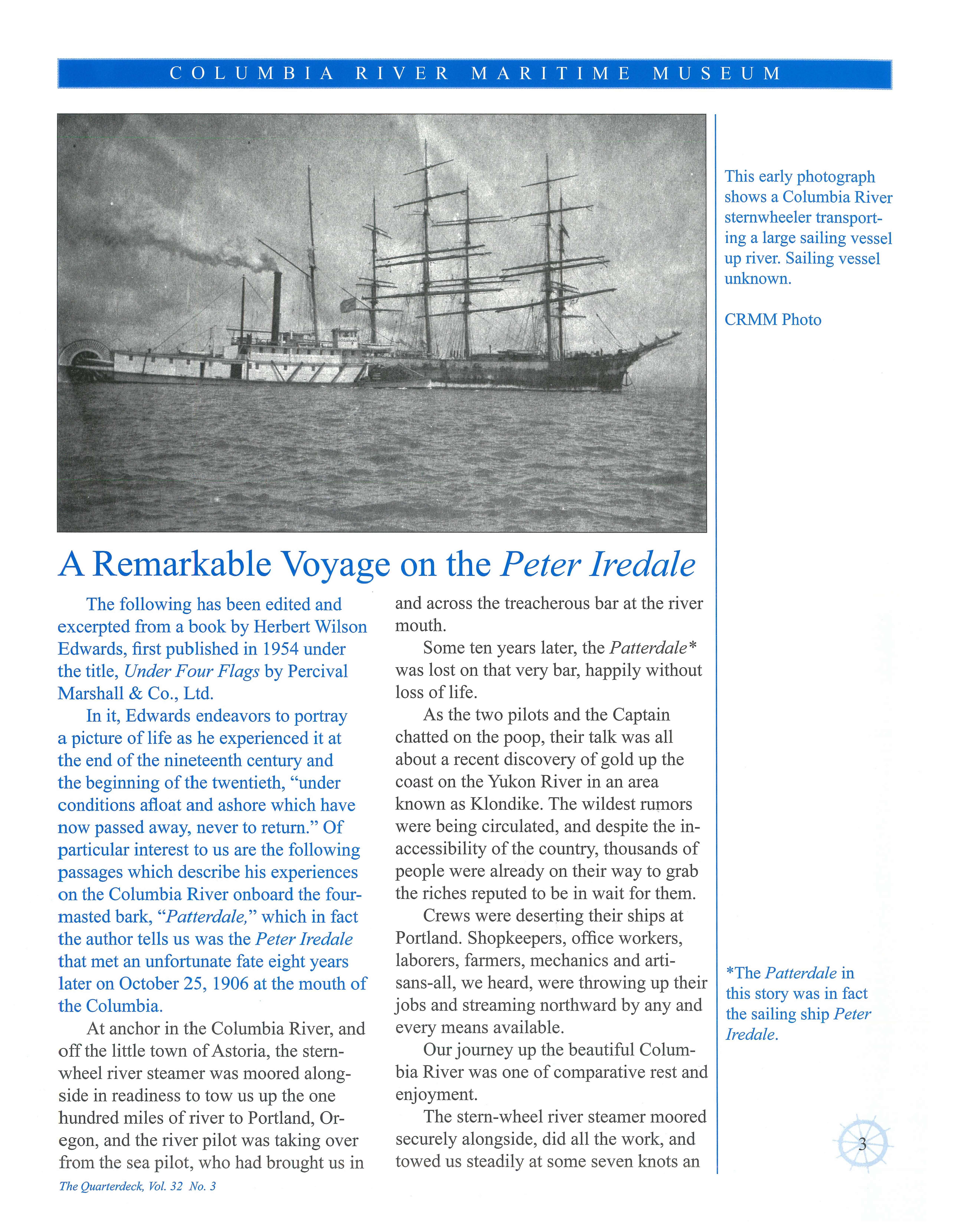
The following has been edited and excerpted from a book by Herbert Wilson Edwards , first published in 1954 under the title, Under Four Flags by Percival Marshall & Co ., Ltd .
In it , Edwards endeavors to portray a picture of life as he experienced it at the end of the nineteenth century and the beginning of the twentieth , " under conditions afloat and ashore which have now passed away, never to return." Of particular interest to us are the following passages which describe his experiences on the Columbia River onboard the fourmasted bark, "Patterdale, " which in fact the author tells us was the Pete r Iredale that met an unfortunate fate eight years later on October 25 , 1906 at the mouth of the Columbia .
At anchor in the Columbia River, and off the little town of Astoria, the stemwheel river steamer was moored alongside in readiness to tow us up the one hundred miles of river to Portland, Oregon, and the river pilot was taking over from the sea pilot, who had brought us in
and across the treacherous bar at the river mouth.
Some ten years later, the Patterdale* was lost on that very bar, happily without loss of life.
As the two pilots and the Captain chatted on the poop, their talk was all about a recent discovery of gold up the coast on the Yukon River in an area known as Klondike. The wildest rumors were being circulated, and despite the inaccessibility of the country, thousands of people were already on their way to grab the riches reputed to be in wait for them.
Crews were deserting their ships at Portland. Shopkeepers, office workers, laborers, farmers, mechanics and artisans-all, we heard, were throwing up their jobs and streaming northward by any and every means available
Our journey up the beautiful Columbia River was one of comparative rest and enjoyment.
The stem-wheel river steamer moored securely alongside, did all the work, and towed us steadily at some seven knots an
This early photograph shows a Columbia River stemwheeler transporting a large sailing vessel up river Sailing vessel unknown .
*The Patt erda le in this sto ry w as in fa ct the sailin g sh ip P eter I re dal e
-----~~COLUMBIA RIVER MARITIME MUSEUM
Th e Quarterdeck, Vo l 32 No. 3
CRMMPhoto
3
Crew photo of the Wide West, a steamer that traveled from Portland to Astoria.
Even the Columbia River Bar Pilots during this time were wearing the bowler hat while at work.
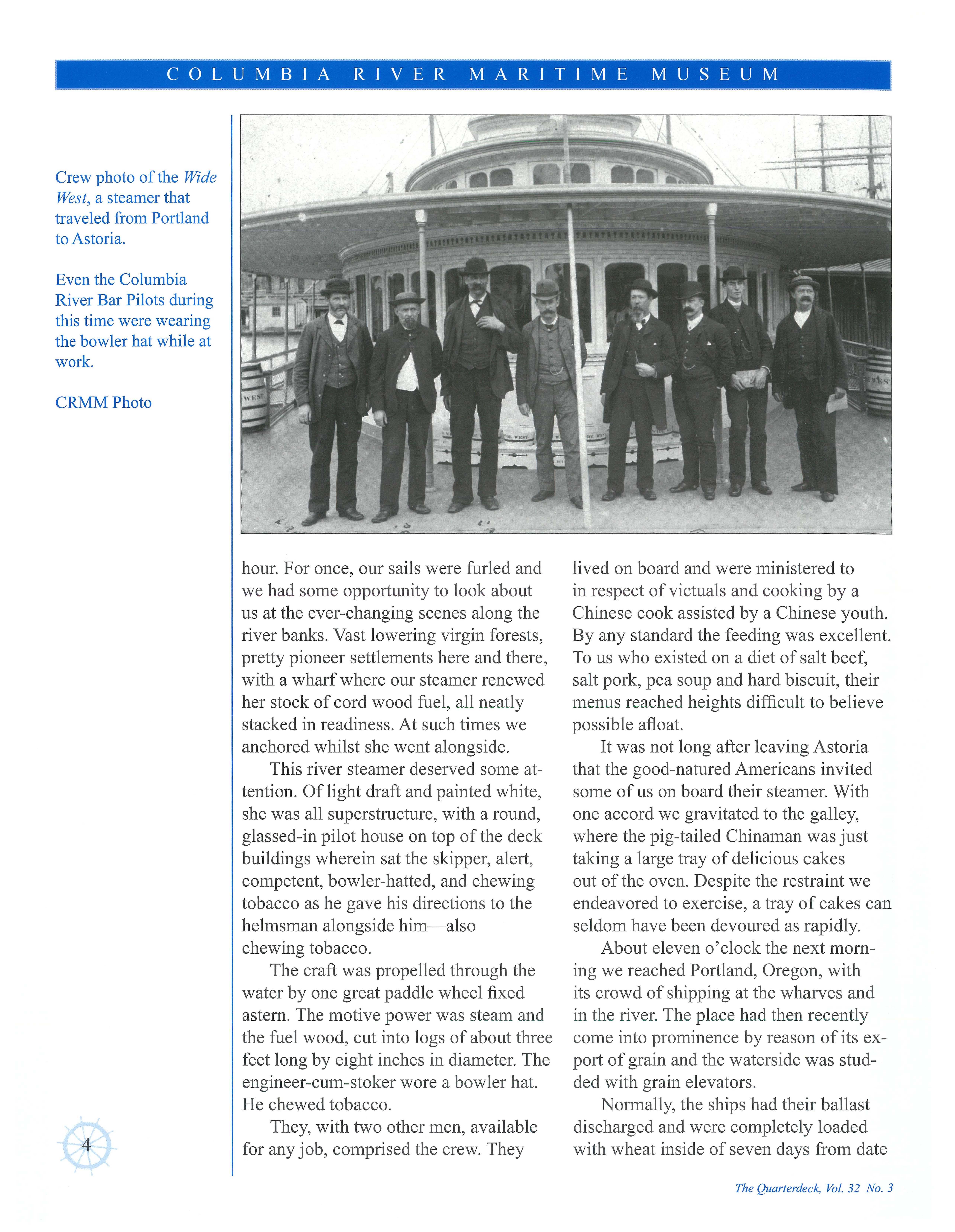
hour. For once, our sails were furled and we had some opportunity to look about us at the ever-changing scenes along the river banks. Vast lowering virgin forests, pretty pioneer settlements here and there, with a wharf where our steamer renewed her stock of cord wood fuel, all neatly stacked in readiness. At such times we anchored whilst she went alongside.
This river steamer deserved some attention. Of light draft and painted white, she was all superstructure, with a round, glassed-in pilot house on top of the deck buildings wherein sat the skipper, alert, competent, bowler-hatted, and chewing tobacco as he gave his directions to the helmsman alongside him-also chewing tobacco.
The craft was propelled through the water by one great paddle wheel fixed astern. The motive power was steam and the fuel wood, cut into logs of about three feet long by eight inches in diameter. The engineer-cum-stoker wore a bowler hat. He chewed tobacco.
They, with two other men, available for any job, comprised the crew. They
lived on board and were ministered to in respect of victuals and cooking by a Chinese cook assisted by a Chinese youth. By any standard the feeding was excellent. To us who existed on a diet of salt beef, salt pork, pea soup and hard biscuit, their menus reached heights difficult to believe possible afloat.
It was not long after leaving Astoria that the good-natured Americans invited some of us on board their steamer. With one accord we gravitated to the galley, where the pig-tailed Chinaman was just taking a large tray of delicious cakes out of the oven. Despite the restraint we endeavored to exercise, a tray of cakes can seldom have been devoured as rapidly.
About eleven o'clock the next morning we reached Portland, Oregon, with its crowd of shipping at the wharves and in the river The place had then recently come into prominence by reason of its export of grain and the waterside was studded with grain elevators.
Normally, the ships had their ballast discharged and were completely loaded with wheat inside of seven days from date
COLUMBIA RIVER MARITIME MUSEUM ,
4
CRMMPhoto
The Quarterde c k, Vol 32 No. 3
of arrival at the port. In those days the waterside workers in United States ports hustled to some tune.
Actually our loading was finished on the evening of the sixth day. The times were however, not normal. The Klondike gold rush was on. Ships still were being loaded quickly, but were unable to sail as their crews had deserted.
With the exception of one able seaman, all the men in our fo'c'sle left us during the first night at Portland.
Some would undoubtedly have succumbed to the prevailing 'gold fever,' but many might have remained had it not been for the ruffian boarding house runners who in those days infested the North Pacific coast ports, and who made a lucrative living by tempting seamen with strong drink and promises of easily gained riches ashore, to desert their ships.
Once they got the men ashore in their boarding houses, they drugged them or hit them over the head. When the unfortunate man again came to his senses, it was to discover that he was on board another deep water sailing ship at sea, outward bound on some long voyage. This process was known as shanghaiing.
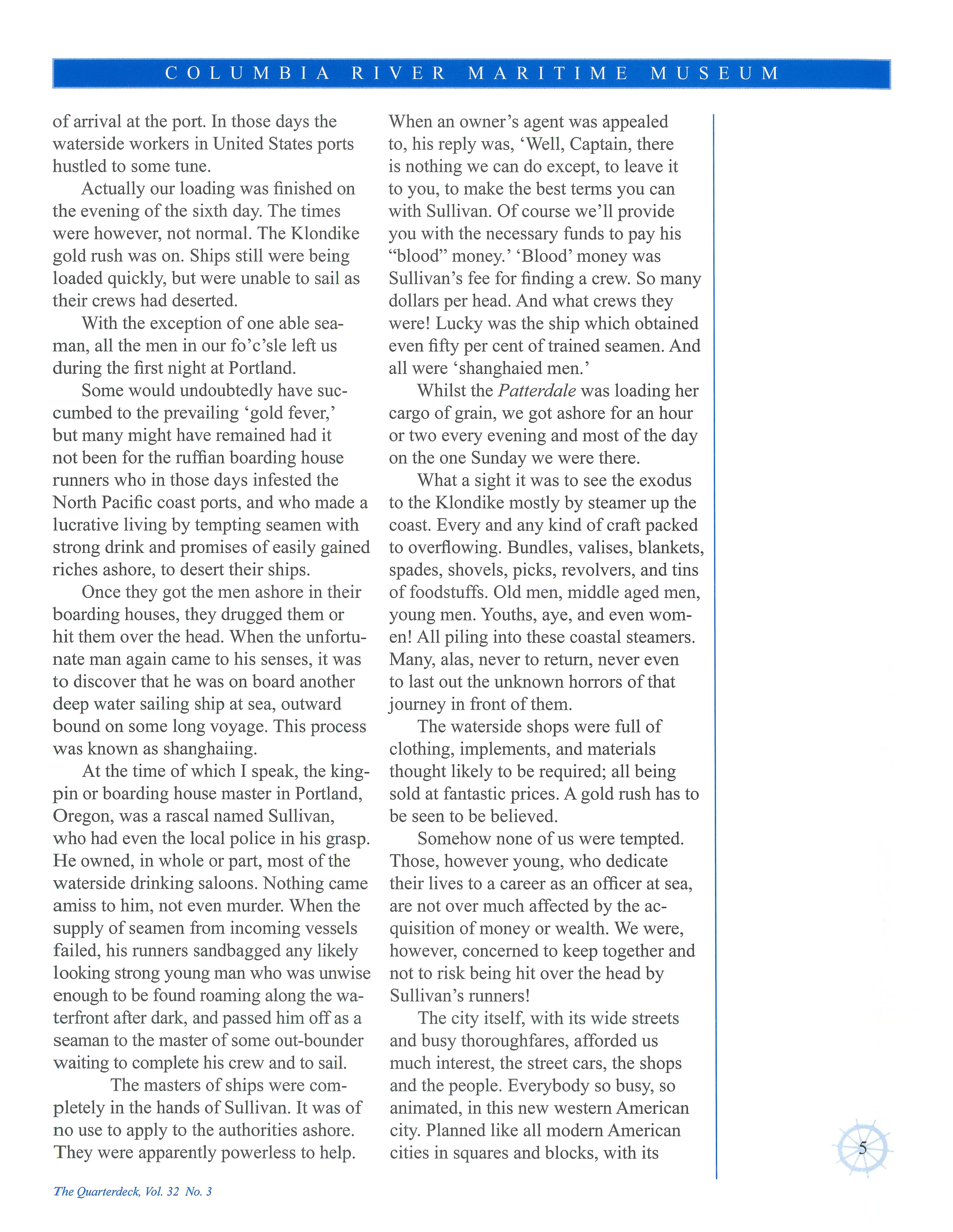
At the time of which I speak, the kingpin or boarding house master in Portland, Oregon, was a rascal named Sullivan, who had even the local police in his grasp. He owned, in whole or part, most of the waterside drinking saloons. Nothing came amiss to him, not even murder. When the supply of seamen from incoming vessels failed, his runners sandbagged any likely looking strong young man who was unwise enough to be found roaming along the waterfront after dark, and passed him off as a seaman to the master of some out-bounder waiting to complete his crew and to sail.
The masters of ships were completely in the hands of Sullivan. It was of no use to apply to the authorities ashore. They were apparently powerless to help.
When an owner's agent was appealed to, his reply was, 'Well, Captain, there is nothing we can do except, to leave it to you, to make the best terms you can with Sullivan. Of course we'll provide you with the necessary funds to pay his "blood" money.' 'Blood' money was Sullivan's fee for finding a crew. So many dollars per head. And what crews they were! Lucky was the ship which obtained even fifty per cent of trained seamen. And all were 'shanghaied men.'
Whilst the Patterdale was loading her cargo of grain, we got ashore for an hour or two every evening and most of the day on the one Sunday we were there.
What a sight it was to see the exodus to the Klondike mostly by steamer up the coast. Every and any kind of craft packed to overflowing. Bundles, valises, blankets, spades, shovels, picks, revolvers, and tins of foodstuffs. Old men, middle aged men, young men. Youths, aye, and even women! All piling into these coastal steamers. Many, alas, never to return, never even to last out the unknown horrors of that journey in front of them.
The waterside shops were full of clothing, implements, and materials thought likely to be required; all being sold at fantastic prices. A gold rush has to be seen to be believed.
Somehow none of us were tempted. Those, however young, who dedicate their lives to a career as an officer at sea, are not over much affected by the acquisition of money or wealth. We were, however, concerned to keep together and not to risk being hit over the head by Sullivan's runners!
The city itself, with its wide streets and busy thoroughfares, afforded us much interest, the street cars, the shops and the people. Everybody so busy, so animated, in this new western American city. Planned like all modem American cities in squares and blocks, with its
: COLUMBIA RIVER MARITIME MUSEUM : ,_ --·-- --~~ !
The Quarterdeck, Vol. 32 No 3
5
The Portland waterfront ca. 1890s. A stemwheel steamer can be seen transporting a sailing ship. CRMMPhoto
avenues running one way and streets at right angles to the avenues, it all looked so new, even as though it had been hastily built, for the electric light standards were of roughly-hewn wood as yet unadorned by paint.
An enthusiastic inhabitant informed us that Portland was the finest city on this or any other earth. Making all allowances, this appeared to be rather an over-statement!
The old part down by the waterfront with its 'Sailor town,' low drinking saloons, and large Chinese community, was of a different caliber. A place to keep away from after dark, and none too safe in daylight, for the unwary.
In Sail with a Shanghaied Crew
The Patterdale had finished loading and now, deep down to her marks, was lying off at the buoys in the middle of the river in readiness to sail when a crew should be obtained.
We had hauled away from the wharf the night before, and now at six o'clock were awaiting the arrival from shore of
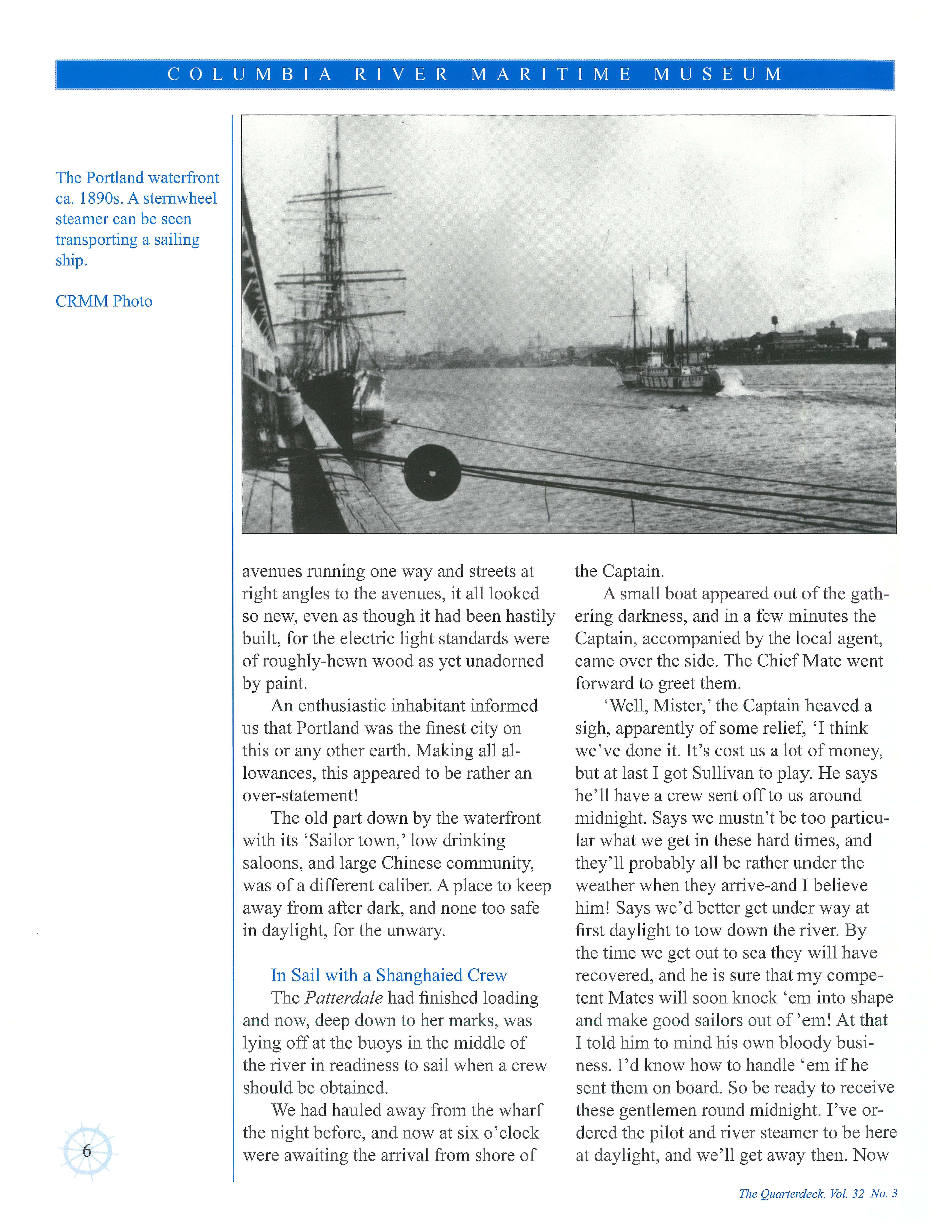
the Captain.
A small boat appeared out of the gath ering darkness, and in a few minutes the Captain, accompanied by the local agent, came over the side. The Chief Mate went forward to greet them.
'Well, Mister,' the Captain heaved a sigh, apparently of some relief, 'I think we've done it. It's cost us a lot of money, but at last I got Sullivan to play. He says he'll have a crew sent off to us around midnight. Says we mustn't be too particular what we get in these hard times, and they'll probably all be rather under the weather when they arrive-and I believe him! Says we'd better get under way at first daylight to tow down the river. By the time we get out to sea they will have recovered, and he is sure that my competent Mates will soon knock 'em into shape and make good sailors out of 'em! At that I told him to mind his own bloody business. I'd know how to handle 'em ifhe sent them on board. So be ready to receive these gentlemen round midnight. I've ordered the pilot and river steamer to be here at daylight, and we'll get away then. Now
---~COLUMBIA RIVER MARITIME MUSEUM ,
6
The Quarterdeck, Vol. 32 No 3
-turning to the agent- 'we'll go into my cabin and sign up the papers Steward, put the whiskey and two glasses on my table.'
After supper the Second Mate came into the half deck. 'You youngsters had better tum in now. We shall want you later to help get these men aboard If they show any fight just hit them hard with anything handy-and be sure you hit first.'
A few minutes after midnight we were called. As we got on deck we could see three boats nearing the ship. Except for the rowers and a man in the stem, no one else was visible. Quietly they crept alongside. The man in the stem of the first boat hailed us in a hoarse whisper. 'Reeve a line through a block in the rigging and send the end down . They're all here.' He pointed to what looked like a heap of sacks in the bottom of the boat. 'The rest are in the other two boats and they are all dead to the world-at present.'
Some thirty odd lifeless bodies were hoisted on board and laid out-not too gently-on deck.
When the last one was inboard the boarding house runner-in-charge followed.
'Throw 'em in the fo'c'sle, Mr. Mate. It'll be some hours before they come to life again. I'll stick around on deck all night until you leave, in case of accidents.' He patted his belt which contained an ugly six-shooter. 'They're sometimes a bit nasty when they come round . '
At daylight-and a cold bitter morning it was-after a cup of milkless coffee and a hard biscuit, we made the tug fast alongside, cast off moorings from the buoys and proceeded down river. With a favorable tide the Patterdale made good progress . By nightfall we were off Astoria where the sea pilot boarded us. During the day not much had been heard of the shanghaied crew, barring an occasional groan or curse. The Mate had taken the precaution oflocking the fo'c'sle down.
Before casting off from the river steamer, we boys, the bos'n, the cook, steward, carpenter, and sailmaker, and those remaining of our original seamen, had gone aloft and loosed the topsails and the foresail.
As the steamer was let go these were sheeted home and the lower staysails set.
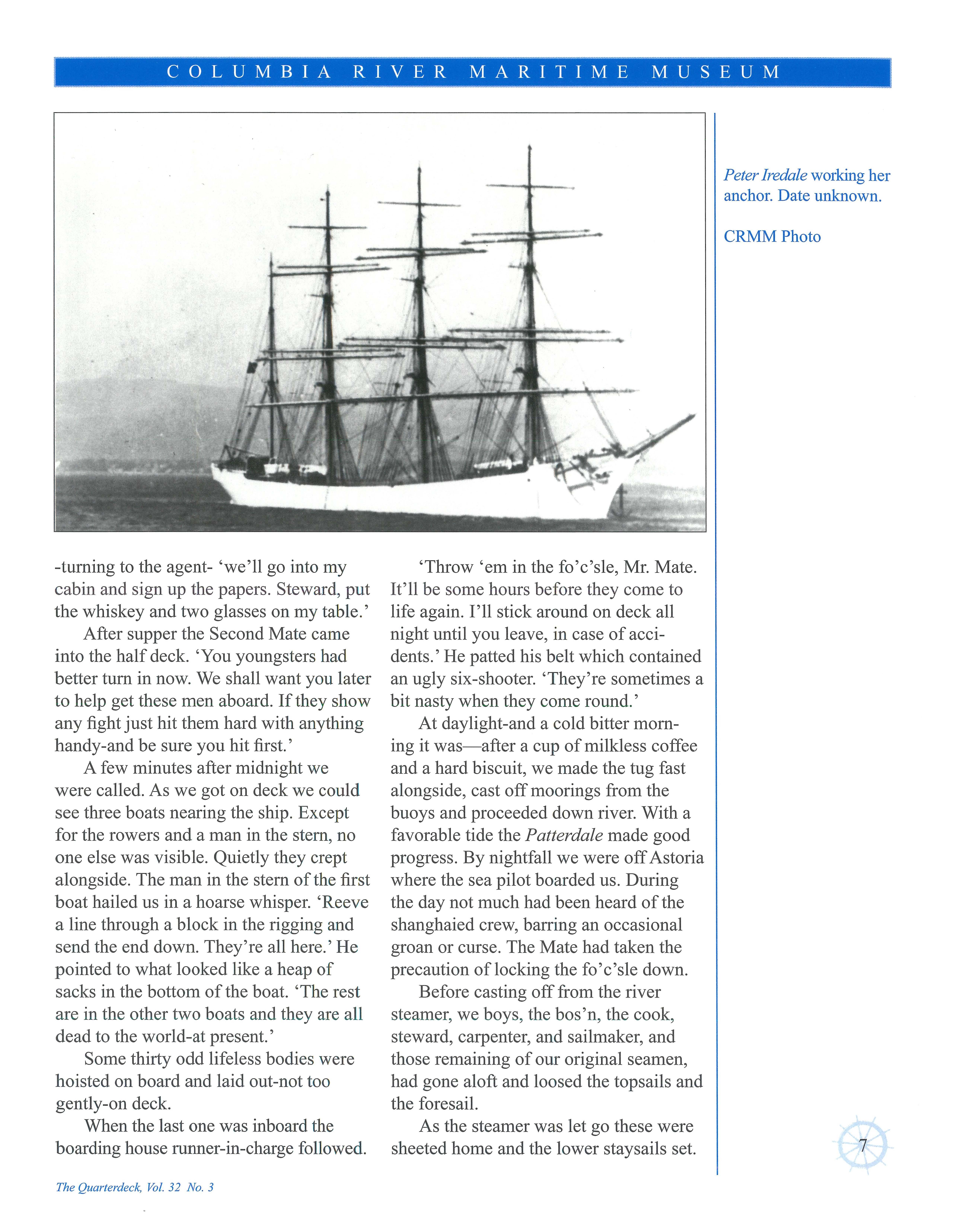
,----- --- -- - --- --c---0 L---u-- M _ B _ I _ A _ --i -- i--v i R ____ MA-R I i -i M-E -M-u -s-- E 0--M---- -- ---- - -, -----·--~--~--·-~ ~-- ---~- ~--
The Quarterdeck, Vol. 32 No. 3
CRMMPhoto 7
Peter Iredale working her anchor. Date unknown .
Crew of the Bark Sonoda!, showing a typical crew sailing the west coast. Life aboard could best be described as difficult and dangerous.
Courtesy of San Francisco National Maritime Museum
The wind being fair and a fresh breeze, we then proceeded under our own sail to clear the bar and get an offing out at sea, when the sea pilot was taken off by his own cutter. We were once again by ourselves on the ocean.
As we drew away from the land under the favorable wind, the Captain and his Mates decided to leave our newly joined shipmates where they were until next morning, despite the fact that they were now beginning to bang upon the fo'c'sle bulkheads and doors to the accompaniment of ever louder screams and curses.
At six in the morning the three mates, the bos'n, and we apprentices mustered at the after hatchway, and mates and the bos'n rolling up their sleeves in workmanlike manner.
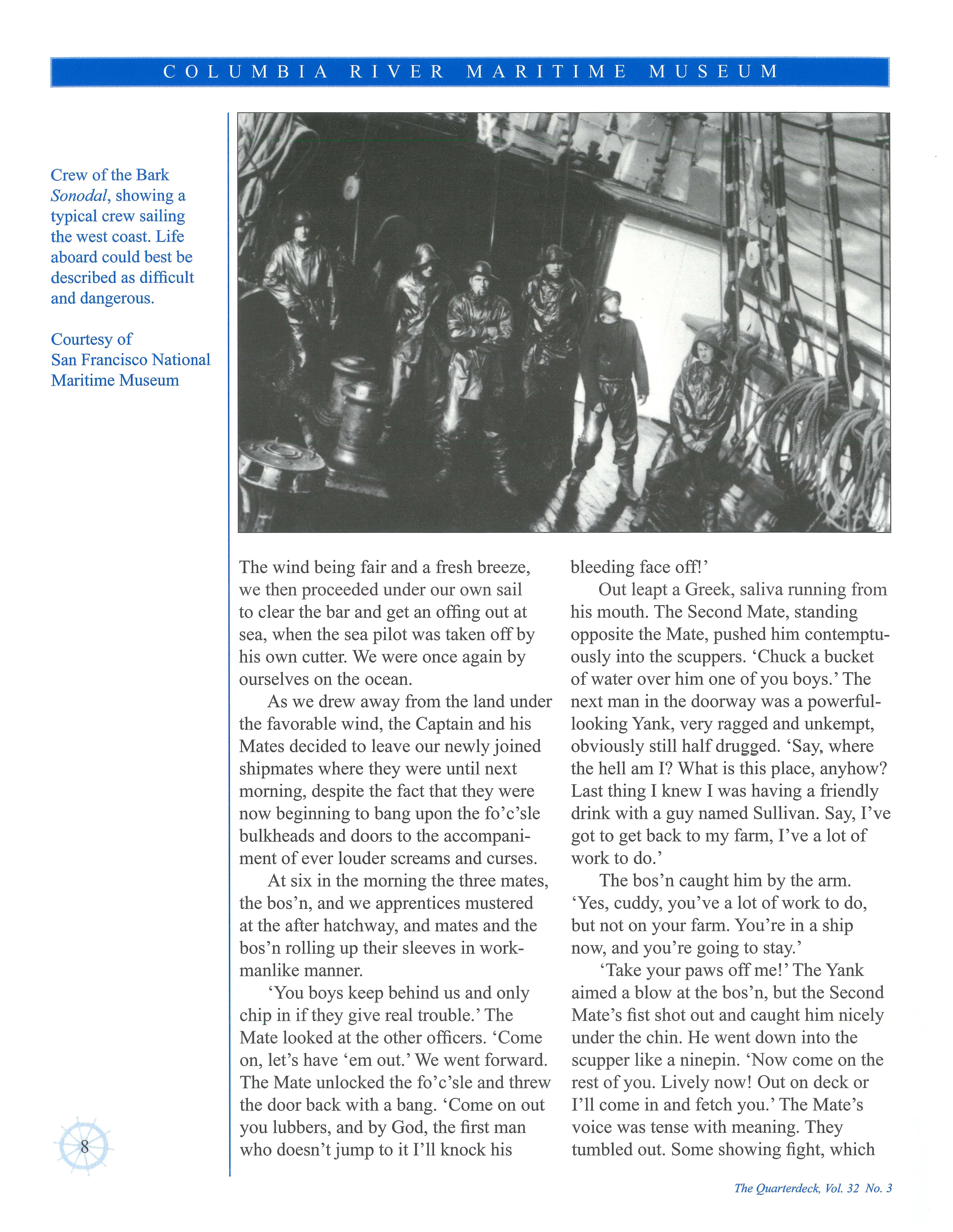
'You boys keep behind us and only chip in if they give real trouble.' The Mate looked at the other officers 'Come on, let's have 'em out.' We went forward. The Mate unlocked the fo'c'sle and threw the door back with a bang. 'Come on out you lubbers, and by God, the first man who doesn't jump to it I'll knock his
bleeding face off!'
Out leapt a Greek, saliva mnning from his mouth. The Second Mate, standing opposite the Mate, pushed him contemptuously into the scuppers. 'Chuck a bucket of water over him one of you boys.' The next man in the doorway was a powerfullooking Yank, very ragged and unkempt, obviously still half drugged. 'Say. where the hell am I? What is this place, anyhow? Last thing I knew I was having a friendly drink with a guy named Sullivan. Say, I've got to get back to my farm, I've a lot of work to do.'
The bos'n caught him by the arm. 'Yes, cuddy, you've a lot of work to do, but not on your farm. You're in a ship now, and you're going to stay.'
'Take your paws off me!' The Yank aimed a blow at the bos'n, but the Second Mate's fist shot out and caught him nicely under the chin. He went down into the scupper like a ninepin. 'Now come on the rest of you. Lively now! Out on deck or I'll come in and fetch you.' The Mate's voice was tense with meaning. They tumbled out. Some showing fight, which
: COLUMBIA RIVER MARITIME MUSEUM : -~
8
The Quarte rde ck, Vol 32 No 3
was promptly quelled by the Mate's hard fists. There were many bloody faces. One man, a negro, picked himself up from the scupper where he had been knocked by the bos'n. Plucking a belaying pin from the rail, he lunged at the Second Mate's head, but the Third Mate kicked his shins just in time and floored him with a blow between the eyes.
All were now on deck except three who pleaded that they were ill. They were thrown out like sacks of potatoes by the Second Mate, who ordered us to 'put a bucket of water over 'em. That'll cure 'em.'
The Mate dusted his hands and rolled down his sleeves. 'Get on your feet there. Stand up. Let's have a look at you. My God! What a party to go round the Hom with!'
The big Yank staggered forward, followed by two others, clearly farm hands like himself.
'Say, you can't do that. Did you say round the Hom in this ship? We've never been in a ship before. We want to go back to our farms and our houses. Tell the Captain to land us right now.'
The Mate thrust his hands into his pockets and surveyed the company with steely eyes.
'Now see here, all of you. Facts are facts, and you may as well know 'em For good or ill-and it's up to yourselves to make it which you like-you are on board the four-masted barque Patterdale, bound round the Hom for a British port. And here you're going to stay till we get there. You can see for yourselves that we are, even now, nearly out of sight of land. And not only are you going to stay in this ship, but you're going to work as seamen. If you don't know what work is like you're going to learn, and if you're not already seamen, you're going to learn that too. And I shan't want you to walk when an order is given; I shan't want you to run I shall want you to fly you sons of bitches. Understand? Fly!'
He paused . 'Now ifthere are any real sailors amongst you, stand out in front.' Only about half the number stepped forward, made up of British, Germans, and Scandinavians.
'Well,' the Mate's tone was easier. 'I'm sorry for you men , but you know how it is. In any case, you're bound homeward, and this isn't a bad living ship, as ships go . Do your duty and you won't have cause to complain. And do your best to make sailors of these others as soon as possible In the meantime, while they're learning, they can do all the cleaning and polishing, and you men will only do real sailorman's jobs.'
'Now, Bos'n,' the Mate looked round, 'tum these men to and get the decks cleared up and the fo'c'sle scrubbed out.'
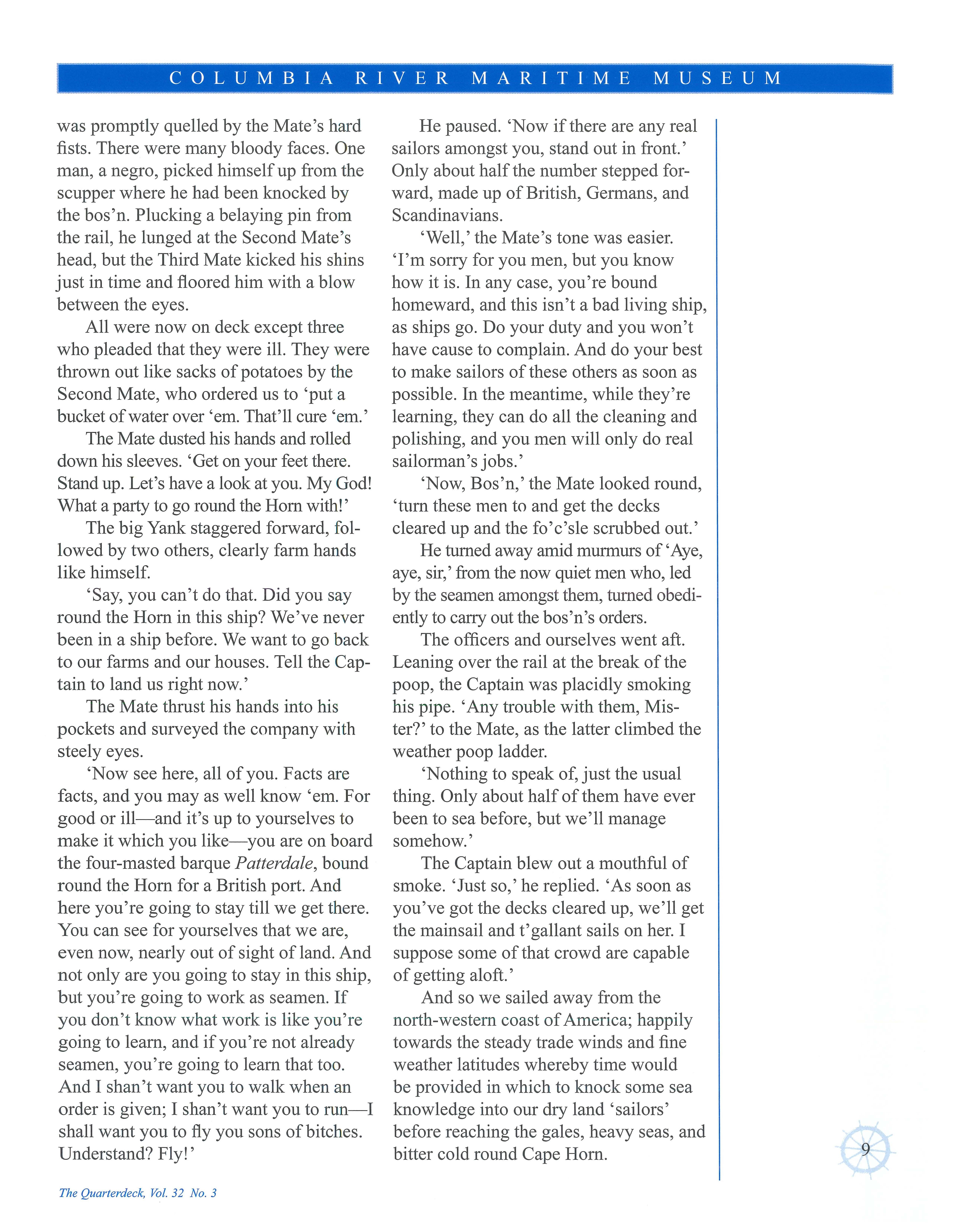
He turned away amid murmurs of' Aye, aye, sir,' from the now quiet men who, led by the seamen amongst them, turned obediently to carry out the bos'n's orders.
The officers and ourselves went aft. Leaning over the rail at the break of the poop, the Captain was placidly smoking his pipe. 'Any trouble with them, Mister?' to the Mate, as the latter climbed the weather poop ladder.
'Nothing to speak of, just the usual thing. Only about half of them have ever been to sea before, but we'll manage somehow. '
The Captain blew out a mouthful of smoke. 'Just so,' he replied. 'As soon as you've got the decks cleared up, we'll get the mainsail and t' gallant sails on her. I suppose some of that crowd are capable of getting aloft.'
And so we sailed away from the north western coast of America; happily towards the steady trade winds and fine weather latitudes whereby time would be provided in which to knock some sea knowledge into our dry land 'sailors' before reaching the gales, heavy seas, and bitter cold round Cape Hom.
i COLUMBIA RIVER MARITIME MUSEUM
The Quarterdeck, Vol. 32 No 3
9
The official account of the grounding and loss of the Peter Iredale.
From the CRMM Library
From the Archives
Transcript of the Naval Court findings issued in London by the Board of Trade on the 24th December 1906.
"(No. 7011.) PETER IREDALE."
FINDING and order of a Naval Court held at the British Vice-Consulate, Astoria, Oregon, on the 12th and 13th days ofNovember, 1906, to investigate the stranding of the British four-masted barque Peter Iredale
The Peter Iredale was a sailing vessel, four-masted steel barque, of 1,993 tons registered tonnage, official number 97790, and built at Maryport, England, in 1890, and belonging to the port of Liverpool, owners P. Iredale & Porter.
It appears from the evidence given before the Court that the ship sailed from Salina Cruz, Mexico, on or about the 26th of September, 1906, with 1,000 tons of ballast, and a crew of 27 hands all told, including two stowaways. No incident worthy of mention happened until the look-out sighted the light on Tillamook Rock at 3 :20 a.m. on the 25th of October, 1906. The ship's course was altered to E.N.E. until the vessel was five miles off the light. The course was then altered to sight the Columbia River lightship. This was sighted and recognized, it bearing N.E. In this position, finding the wind was veering to westward, and having lost sight of the light in a thick mist, it was decided to wear ship to avoid the influence of the current setting to the north, and the tide running into the Columbia River. The wind had now hauled to north of west in heavy squalls with rain. Just before striking, while in the act of wearing, an exceedingly heavy west northwest squall struck the vessel, throwing her head off, she taking the ground, and shortly afterwards losing her upper spars. She then drove ashore, with a high southwest sea running, and a fresh westerly gale
We consider that everything was done by the master to get his ship out of danger, but that the set of the current and the sudden shift of wind drove him so close in that in the act of wearing around to get his ship's head off shore, she stranded. The Court, having regard to the circumstances above stated, finds as follows:-
That the position of the ship before the shift of wind was not one of danger. She was in the usual cruising ground of the pilot schooner, but unfortunately no pilots were on the station, the pilot boat being in port under repairs.
We consider that prompt action was taken by the master immediately the wind shifted, to get his ship's head off shore, and by all accounts he was ably seconded by his officers and men. Having carefully considered the evidence, we do find that the master, and his first and second officers, are in no wise to blame for the stranding of the said vessel, and their certificates having accordingly been returned to them.
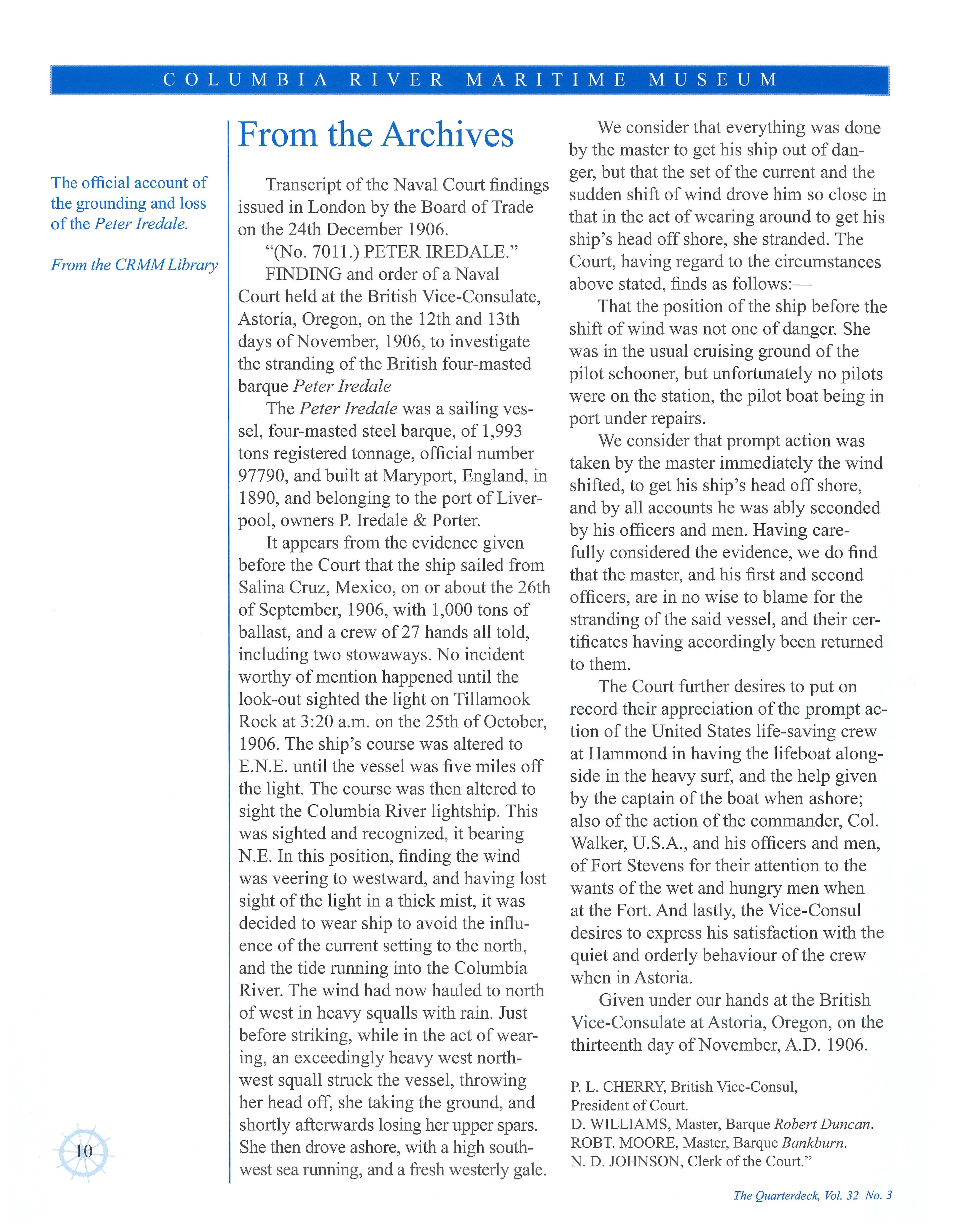
The Court further desires to put on record their appreciation of the prompt action of the United States life-saving crew at Hammond in having the lifeboat alongside in the heavy surf, and the help given by the captain of the boat when ashore; also of the action of the commander, Col. Walker, U.S.A., and his officers and men, of Fort Stevens for their attention to the wants of the wet and hungry men when at the Fort And lastly, the Vice-Consul desires to express his satisfaction with the quiet and orderly behaviour of the crew when in Astoria.
Given under our hands at the British Vice-Consulate at Astoria, Oregon, on the thirteenth day of November, A.D . 1906.
P L. CHERRY, British Vice-Consul , President of Court
D. WILLIAMS, Master, Barque Robert Duncan. ROBT. MOORE, Master, Barque Bankburn. N D JOHNSON , Clerk of the Court."
,- . . .. C () L .tT M . B I A .. R I V E R M A R I T I M E M u s E . u M ,
10
The Quarterdeck, Vol. 32 No. 3
The Wreck of the Peter Iredale
"By the time we arrived, boats were already bringing in crewmen. The last surfboat came through the breakers, and in it were Captain Lawrence and First Mate Clayton. I waded out waist-deep in the spume from the waves, and carried Lawrence ashore."
"He was an Englishman, about forty or forty-five, and was neatly dressed. His well trimmed Van Dyke beard was red. As I brought him in he told me that he thought that they were fifty miles out from the Columbia River when his ship hit the beach south of the jetty."
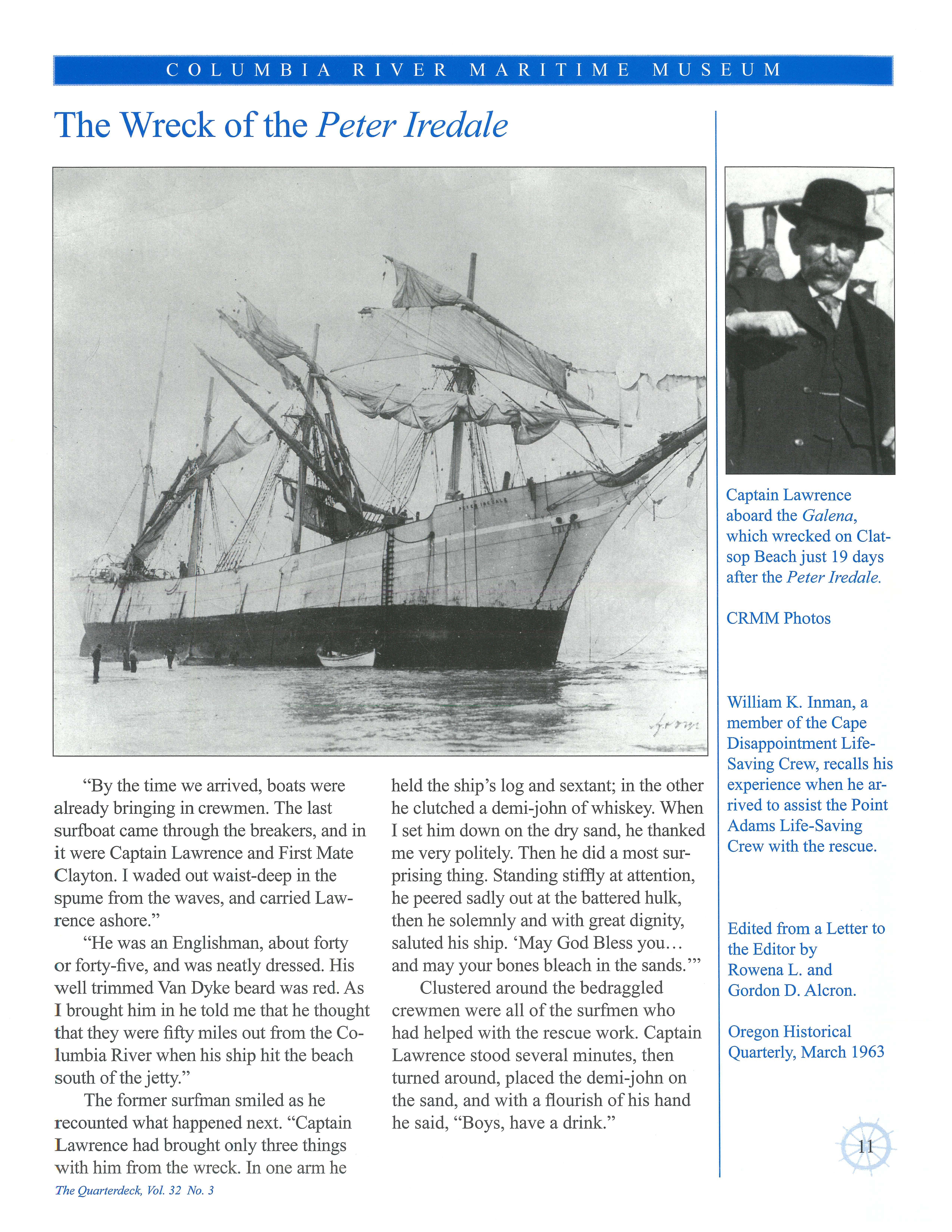
The former surfman smiled as he recounted what happened next. "Captain Lawrence had brought only three things with him from the wreck. In one arm he
held the ship's log and sextant; in the other he clutched a demi-john of whiskey. When I set him down on the dry sand, he thanked me very politely. Then he did a most surprising thing. Standing stiffly at attention, he peered sadly out at the battered hulk, then he solemnly and with great dignity, saluted his ship . 'May God Bless you ... and may your bones bleach in the sands."'
Clustered around the bedraggled crewmen were all of the surfmen who had helped with the rescue work. Captain Lawrence stood several minutes, then turned around, placed the demi-john on the sand, and with a :flourish of his hand he said, "Boys, have a drink."
CRMMPhotos
William K. Inman, a member of the Cape Disappointment LifeSaving Crew, recalls his experience when hearrived to assist the Point Adams Life-Saving Crew with the rescue.
Edited from a Letter to the Editor by Rowena L. and Gordon D . Akron.
Oregon Historical Quarterly, March 1963
: COLUMBIA RIVER MARITIME MUSEUM ----~-
T h e Quarterdeck, Vol. 32 N o 3
Captain Lawrence aboard the Galena, which wrecked on Clatsop Beach just 19 days after the Peter Iredal e .
11
Portrait of Peter Iredale (1823-1899)
Courtesy Thomas Iredale
These pictures were taken of the launch of the Kinkora, another Iredale ship, built in 1888.
Courtesy Thomas Iredale
Peter Iredale
Cumbrian Master Mariner Ship-owner by Thomas Peter Iredale
Exactly six years and one day after Peter Iredale died, the four-masted bark Peter Iredale ran aground on Clatsop Beach in 1906, whilst trying to enter the Columbia River. The wreck has lain lhere rusting away for 100 years . But this is another story.
Instead we take a brief look at the man, where he came from, the times he lived in and the fleets that he built up. We will not only touch on the biographical aspects about this 19th century shipping magnate, but also on the maritime scene during his lifetime, together with some geographical and historical background of Great Britain and West Africa. This will help us to understand the era in which Peter Iredale made his fortune. The early years and off to sea
Peter Iredale was born not far from Maryport, in Great Broughton on 12th May 1823, the third child of John and Elizabeth Iredale and baptized just over
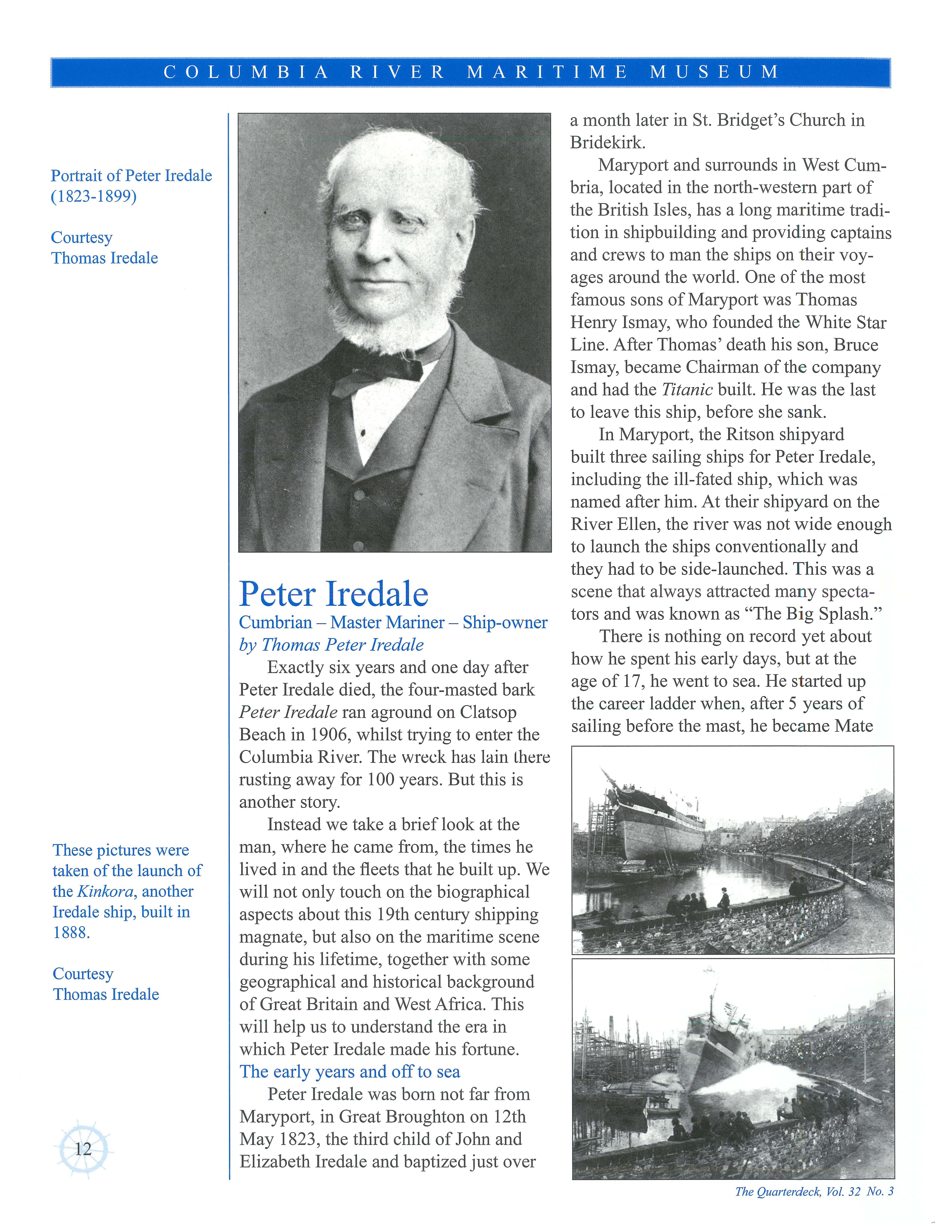
a month later in St. Bridget's Church in Bridekirk.
Maryport and surrounds in West Cumbria, located in the north-western part of the British Isles, has a long maritime tradition in shipbuilding and providing captains and crews to man the ships on their voyages around the world. One of the most famous sons of Maryport was Thomas Henry Ismay, who founded the White Star Line. After Thomas' death his son, Bruce Ismay, became Chairman of the company and had the Titanic built. He was the last to leave this ship, before she sank.
In Maryport, the Ritson shipyard built three sailing ships for Peter Iredale, including the ill-fated ship, which was named after him. At their shipyard on the River Ellen, the river was not wide enough to launch the ships conventionally and they had to be side-launched. This was a scene that always attracted many spectators and was known as "The Big Splash."
There is nothing on record yet about how he spent his early days, but at the age of 17, he went to sea. He started up the career ladder when, after 5 years of sailing before the mast, he became Mate
12
The Quarterdeck, Vol. 32 No. 3
on the Princess Royal of Liverpool and also served in this capacity on the Buenos Ayrian until March 1848. In those days, a Second Mate would earn around £4 a month (worth today: £306 or $507) and a First Mate £7 (worth today: £535 or $997). A ship's captain could earn upwards of £12 a month (worth today: £800 or $1,490) plus a share in the profits. The purchasing power of £100 in 1850 was around £7,200 ($13,418) when compared to today.
From 1848 until February 1851, no records are available as to his activities, but from then until March 1853, he served as Mate on board the Princess Royal again, the last month as first Mate. Now 30 years old and based in Liverpool, the most vibrant and important sea port of the United Kingdom. Liverpool owed its initial wealth to the slave trade, but this stopped in 1807 when England abolished its participation in the trade. Then Liverpool turned to industrial manufacturing and continued to prosper its merchants also putting their resources into opening up new fields of trade with West Africa. Palm oil was one commodity for which a steady and expanding market existed in Europe and the trade in palm oil, cocoa, timber and ground nuts largely came to replace the earlier trade in ivory, gold and slaves.
In Liverpool, Peter Iredale sat the examination for the Master Mariner's Certificate on the 8th April 1853. According to the testimonials he produced, he had 13 years and 3 weeks of service at sea. A week later, he married Betty (Bessie) Archer, daughter of Joseph and Martha Archer, a ships' victualler and yeoman of Dovenby. The marriage took place in the same church in Bridekirk, where he was baptized. From 1854 until the early 60s, he acted as factor, supercargo or coastmaster in West Africa for Messrs Stuart & Douglas of Liverpool. Trade with West Africa: Stuart & Douglas
The Liverpool-based firm of Stuart & Douglas was established in 1845 and it opened up the Brass River trade and expanded operations to the towns of Bonny and Calabar on the inhospitable sea coast of what is now known as Nigeria.
Stuart & Douglas' principal agent, a certain Mr. Jackson is reported to have earned £10,000 commission in three years. He is mentioned to give some idea of the money that could be made in West African trading. The average salary for a factor or agent in West Africa was around £12 a month (worth today: £800 or $1,490) plus commission. Ifwe
quarter Mr Jackson's average yearly commission £833 then, at today's value, we are looking at some £50,489.10 or $94,091 (using the retail price index). If Peter Iredale were to have been employed there for 5 or 6 years, it could be safely assumed that he would have been able to save enough capital to finance the start of his fleet of ships.
Although the possibilities existed there to make a fortune, the risk to health was enormous, as none of the medical facilities we know today existed even in a most rudimentary fashion, whilst Peter was there . He was fortunate, not to have succumbed to disease. Indeed-in an obituary, it was written that "He was a man of
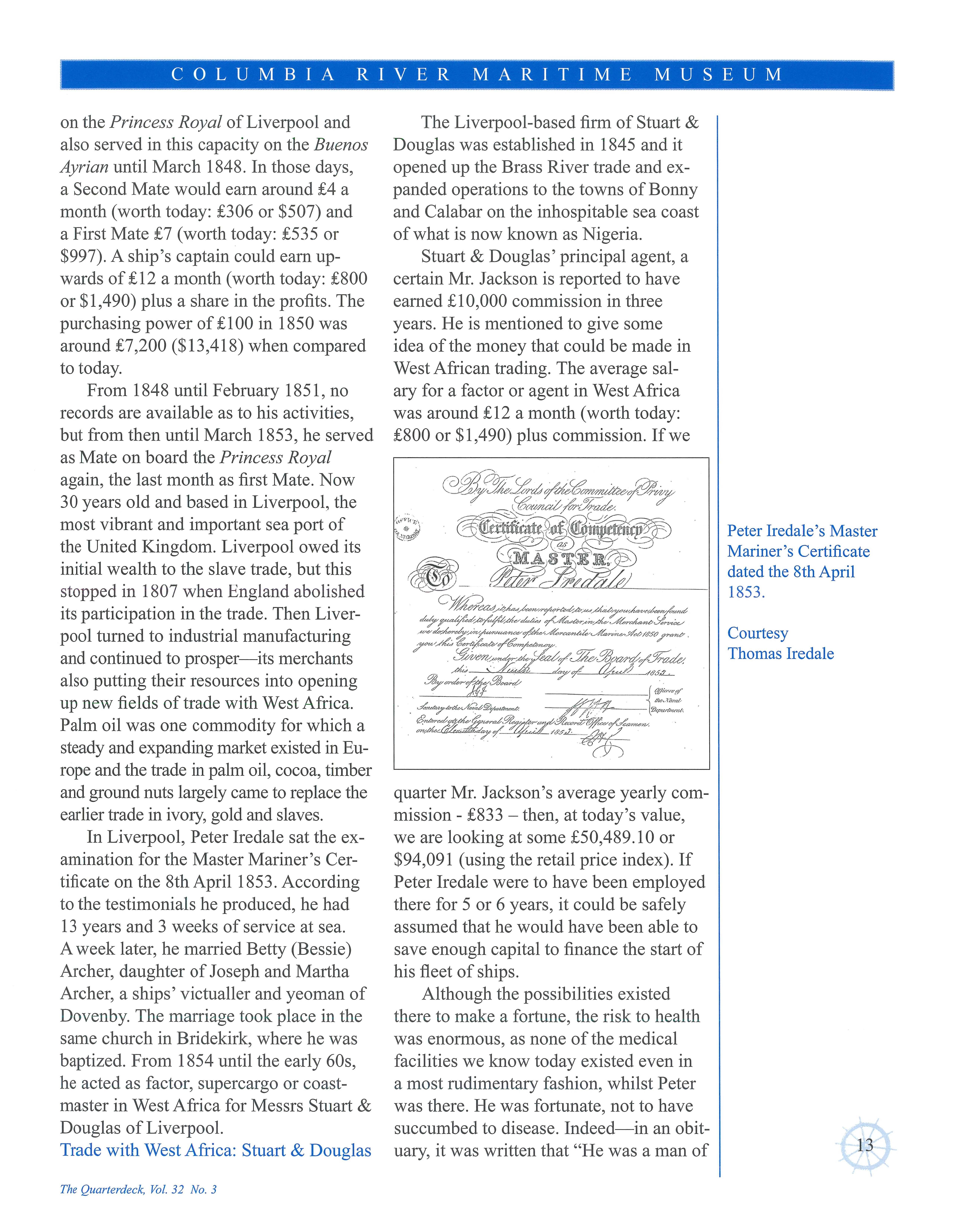
: COLUMBIA RIVER MARITIME MUSEUM 1 ~--~ -~
The Quarterdeck, Vol. 32 No. 3
13
Peter Iredale's Master Mariner's Certificate dated the 8th April 1853 . Courtesy Thomas Iredale
Peter
CRMMPhoto
great vigor and possessed an iron constitution. He fought down fearlessly, even scornfully, attacks of all kinds, recovering from Yellow Jack coast fevers, and other troubles, until he became almost inured from disease. While many others perished on that fatal coast, he triumphed over every disease, by which he was assaulted."
Unlike his brothers, John (born 1830) who died in Bonny in 1859 at the age of 29 and Joseph (born 1842), who died in Calabar in 1862 aged 20. It would be a reasonable assumption that the brothers worked together, as at Stuart and Douglas, it was the custom for agents at Bonny to also have a vessel at New Calabar, and to work both Bonny and New Calabar through the services of an assistant agent. Finally, it is interesting to note that Stuart and Douglas were represented at Peter Iredale's funeral.
Allegations of slave trading

Although slavery had been banned by
Britain in 1807, there are ample accounts that it continued and the slaves could also have been shipped out of the (now) Nigerian ports. No evidence could be found, that Stuart and Douglas were involved in the absolutely illegal, but hugely profitable slave trade, during the time that Peter Iredale worked for them. However, there is a serious allegation by Capt. Frank H. Shaw in his book "Seas of Memory" published in 1958, that "Peter Iredale, the owner of the Dovenby, whom I later met, was a shameless opportunist, who ran his fleet on the thriftiest lines. He had made money in the slave-trade, running Black Ivory from the Guinea Coast to the Southern States; and had invested his gains in a considerable fleet of windjammers, all of them strictly utilitarian and run much as he had run his Middle Passage contrabandists. He manned his vessels with romantic boys for the most part, supplementing them by the minimum allowable of fore-deck hands. He bought condemned Navy stores for feeding his flock. He was a flint-hearted
COLUMBIA RIVER MARITIME MUSEUM : --~
Iredale leaving the historic port of Dunkerque, France in 1899.
14
The Quarterdeck, Vol. 32 No. 3
miser, and seldom contacted his victims in person."
Who knows what might have inspired this volatile outburst!
The first sh ip
Armed with sea-going and trading experience and presumably, an adequate amount of capital, he began his career as a ship-owner. He had the iron bark Calabar (496t) (and abandoned in 1872) built for him in 1864 by Williamson of Harrington, just down the coast from Maryport. He personally owned 44 shares in this vessel. Giving this name to his first ship could have reflected the strong recent association with West Africa. It is not yet known what this ship actually cost, but as a comparison, the Cutty Sark (963t) built in 1869 cost £21/ton to build. Using this figure as a basis, the Calabar with its 496 tons, would have cost around £10,416 (value today : £688,594.26 or 1.3 million US dollars). With 44 (of the 64) shares in the vessel and using the estimated figures above, his investment would have been £7,161 The financing of shipbuilding and the operation of ships, with its risks and rewards is neatly described in an account from the Welsh coastal town of Nefyn: "The considerable finance required to build ships in the absence of powerful institutions was provided for by local people such as preachers, quarrymen and shopkeepers who were all filled with a fervent hope of having a good return on their hard earned money. This investing fever swept through the country villages such as Bethesda which held the complete shares in one ship. Each ship was divided into sixty four shares, which were offered for sale to the public, four shares were called an ounce. The captains and their families were always offered the first option, and consequently became substantial holders, but merchants outside Nefyn involved with these ships' cargoes, always scenting profit, became active investors.
Interestingly, the local landed moneyed class, apart from the quarry owners, showed no interest in investing in these ships, being more interested in developing railways. There was no organized agency for selling these shares, which would be advertised by word of mouth, but advertisements did sometimes appear in the press.
In modem parlance these investments because of their high losses and the fickleness of world trade were 'high risk,' the final deep recessions in the 1880s made many a shipping company bankrupt and cost some dearly. In a time of great religious zealousness with gambling frowned upon (in Wales), these investments were amazingly tolerated with no comment!
It could be highly lucrative with one's investment being returned in three years, a 25% return was quite common."
Peter
Iredale's
children
In 1859, his son Joseph Henry was born and would later join his father as a partner, until Joseph earned his father's displeasure and the partnership was dissolved.
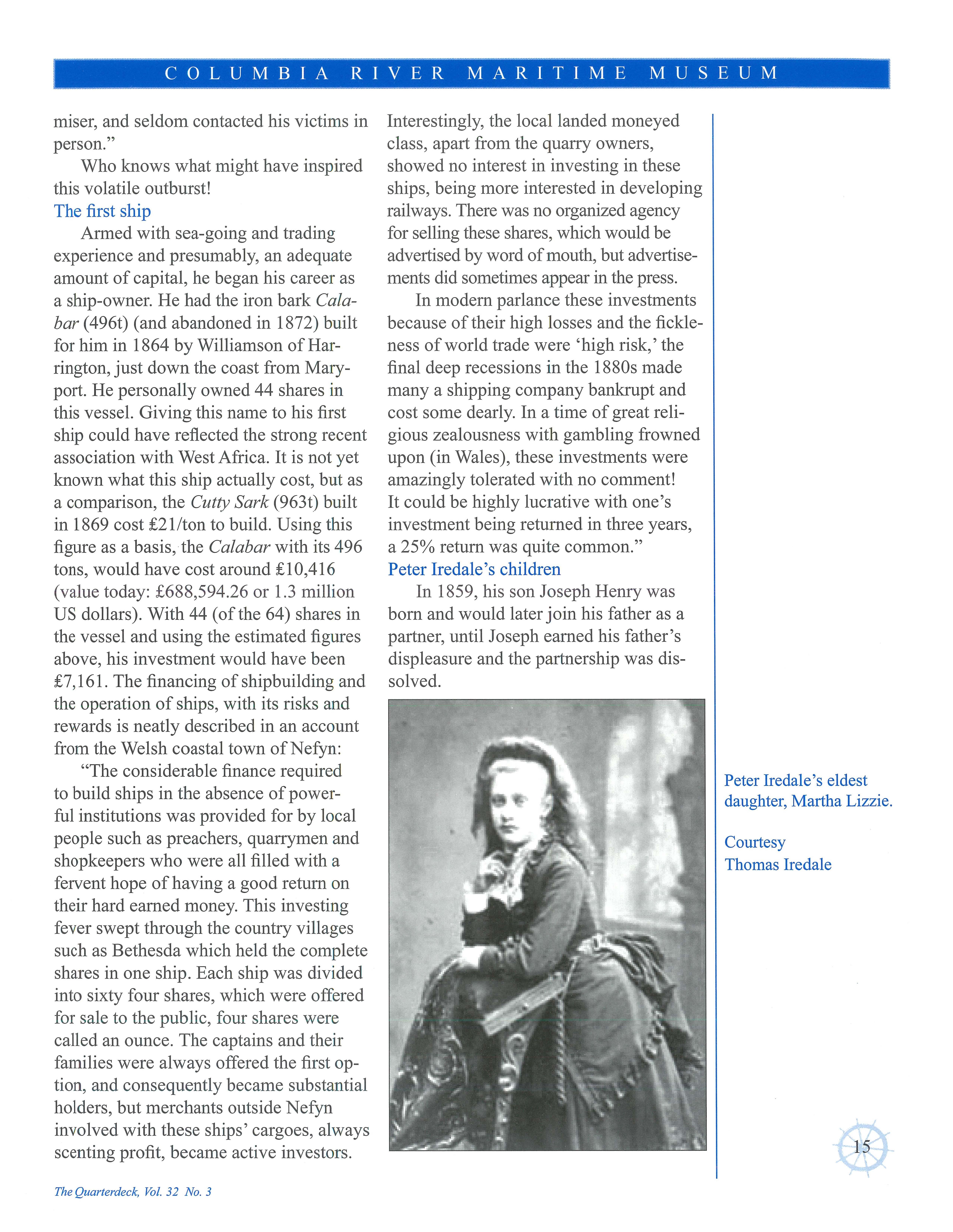
COLUMBIA RIVER MARITIME MUSEUM
The Quarterdeck, Vo l 32 No 3
Peter Iredale's eldest daughter, Martha Lizzie
15
Courtesy Thomas Iredale
Design of PI&Co flag flown on all company ships
Courtesy Thomas Iredale
Peter's eldest daughter, Martha Lizzie was born in 1861 and she married ' John Porter in 1885, a fusion of personal as well as business interests, as John came from the family of William Porter, a ship-owner from Belfast.
Sadly, Peter's second daughter, Mary Isabella, died three weeks after being born in 1866 at Dovenby and who was interred at Bridekirk, a religious focal point for this Iredale family. Two years later, his third daughter, Ada Mary Isabel, was born, but who was to tragically die in 1879 before she was eleven years old. P. Iredale & Co 1868 and 1879
Between 1868 and 1879, as P. Iredale & Co, he had 14 ships built in relatively quick succession: Lizzie Iredale, (693t) 1868 (missing 1887); Vale of Doon (687t) 1869 (sold in 1888 to WB Jones, Liverpool); the firstDovenby (871t) 1871 (sunk in collision with the Argomene 1890); Ada Iredale (1032t) 1872; Seaton (757t) 1873 (wrecked at Billiton 1875); Great Broughton (828t) 1874 (wrecked in the Columbia River 1881 ); City of Carlisle (859t) 1875 (1897 abandoned in N. Atlantic); Ullock (815t) 1875 (sold to Norway, renamed Johanne in1894); Martha Fisher (811t) 1875; Lizzie Bell (1036t) 1877; Archer (789t) 1876 (broken up in San Francisco in 1894); Cockermouth (1377t) 1876; Cumbrian (1053t) 1879 and acquired the Mary Ann Wilson (897t) 1871 (wrecked on Blenheim Reef 1878). Most of these ships were named after Cumbrian villages or members of his family.
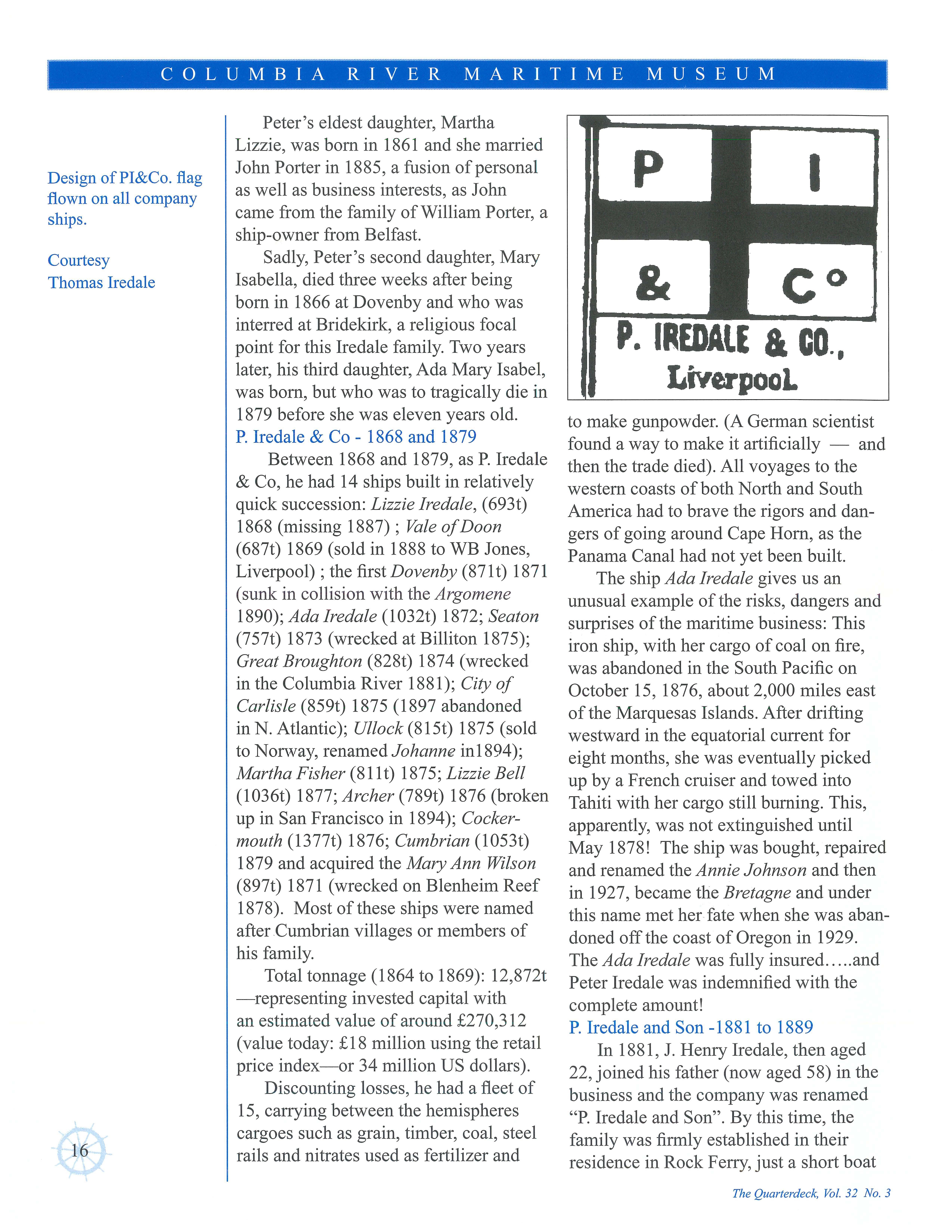
Total tonnage (1864 to 1869): 12,872t -representing invested capital with an estimated value of around £270,312 (value today: £ 18 million using the retail price index-or 34 million US dollars).
Discounting losses, he had a fleet of 15, carrying between the hemispheres cargoes such as grain, timber, coal, steel rails and nitrates used as fertilizer and
& co
P. IRmAlE & CO., LiverpooL
to make gunpowder. (A German scientist found a way to make it artificially and then the trade died). All voyages to the western coasts of both North and South America had to brave the rigors and dangers of going around Cape Hom, as the Panama Canal had not yet been built.
The ship Ada Iredale gives us an unusual example of the risks, dangers and surprises of the maritime business: This iron ship, with her cargo of coal on fire, was abandoned in the South Pacific on October 15, 1876, about 2,000 miles east of the Marquesas Islands. After drifting westward in the equatorial current for eight months, she was eventually picked up by a French cruiser and towed into Tahiti with her cargo still burning. This, apparently, was not extinguished until May 1878 ! The ship was bought, repaired and renamed the Annie Johnson and then in 1927, became the Bretagne and under this name met her fate when she was abandoned off the coast of Oregon in 1929. The Ada Iredale was fully insured ..... and Peter Iredale was indemnified with the complete amount!
P
Iredale and Son -1881 to 1889
In 1881, J. Henry Iredale, then aged 22, joined his father (now aged 58) in the business and the company was renamed "P. Iredale and Son". By this time, the family was firmly established in their residence in Rock Ferry, just a short boat
16
I
The Quarterdeck, Vol. 32 No. 3
ride across the River Mersey from the Liverpool Docks and the Shipping Exchange. Five years after it began, the partnership with his son, Joseph Henry, was dissolved in 1889. In the same year J. Henry married Anne Porter (sister of John Porter). He went into shipping on his own account. The disso lution was by no means cordial and in his private journal (which is in the author's possession), Peter wrote to his son on 21st November 18 8 8, that he was most displeased with the way his son was "speculating in wheat shipments and that he could not put the money of his shareholders and friends at risk. and the worst part of the business in futures, is that you do it without my sanction even keeping me from knowing anything until after it's done, and in several cases, you have actually done your best to prevent me getting to know things you had done, until they had to be forced out of you. Yours Respectfully "
I do not have any access to Joseph Henry's correspondence, but a month later, Peter acknowledged a letter from his son on 20 December 1888 as follows:
Joseph Henry Iredale Esq. Dear Sir,
I received your note this date giving notice of a dissolution ofpartnership between us to expire 20 Dec 1889 to which 1 agree .
Yours truly
And that, it seemed was that! Short and sweet nothing more to be said.
It is probably fortuitous, that Peter Iredale's wife, Martha knew nothing about the rift between father and son, as she had died the year before. But nevertheless, it a.o~ r . :J-.-r¢,.Fi) N-uvuf ~Ji,~
.l?Jru.i}f) ~, ri.e.~ t::: ..-,;;o; -t#ii:.I o( d.Cb i~'i.'.v "f ... 61- j, «Ahl't.lJ'UJ~ (.LI b l #f a,urltl.UtA g ~,w • f/tTUN friiil( . ----- ==.. 00 "
must have been disappointing for Peter that the son did not carry on the business.
As "P. Iredale and Son," the existing fleet was expanded to include the following vessels: Embleton (1196t) 1881; Allonby (1451t) 1882; Vale of Doon (687t) 1882; Astoria (1429t) 1885; Bessfield (1322t) 1886; Derby Park (1292t) 1887 (out ofregister 1889); Kinkora (1630t) 1888; Lorton (1380t) 1888.
New tonnage (1880 to 1889) : 9,265t representing invested capital with an estimated value of around £194,565.00 (value today : £14 million using the retail price index or 26 million US dollars).
Sailing ship Ada Iredale. Courtesy Thomas Iredale
Original correspondenc e from Peter Iredale to his son. December 20, 1889 Courtesy Thomas Iredale

I ' C O _ L U M B I A R I V E R M A R I T I M E M u s E u M
Th e Quarterdeck, Vol. 32 No. 3
17
Total capital invested in ships 18641889 = approx. 89 .5 million US dollars (today's value)
P. Iredale & Porter Ltd (until 1899)
With the reforming of the company in 1890 to become "P. Iredale & Porter Ltd," Peter Iredale himself was 67 years old and still fully involved with the dayto-day running of the fleet. He took on his son-in-law (who had been to sea himself) aged 30 as his new partner.
The company still continued to acquire sailing ships with greater tonnage. The new ones were: Kinkora (1630t) 1888 (abandoned waterlogged and afterwards wrecked on Clipperton Island in1897); Drumalis (2530t) 1890; Ulidia (2378t) 1889 (wrecked on Stragglers Reef, Freemantle in 1893 and now a designated wreck, protected by Aus-
Ladore (1670t) 1892; Mowhan (2873t) 1892 (The Mowhan was the largest ship that Peter Iredale had ever owned); Iredale (1490t) 1894; Lonsdale (1889t) 1894 (now still floating as a hulk in Punta Arenas, Chile).
The final years and valedictory Mr. A. Leon Marsh, an ex-officer apprentice and executive with P. Iredale & Porter, reflected in his memoirs, that: " .... Mr. Iredale had been brought up in a hard school for seafaring life in his early days was a very different matter from nowadays. He was a great individualist with a wide knowledge of humanity. Apparently rigid in control and stem against wrongdoing he had an underlying very human understanding and tolerance and a sense of humor known perhaps only to those in intimate day-to-day contact with him. His memory was astonishing. Almost up to his death, he dealt with the ship's provisioning and stores and I used to have to be at the office at 8 o'clock on those mornings when we went through them. From one voyage to another he could recollect exactly what that ship had received before-and some vessels would be away from home port for over a year-and years in cases and many a time till I got very wary, he slyly tripped me up on the details."
tralian law) Peter Iredale (2075t) 1890; Dovenby (1653t) 1891 (the second of this name and in 2006 is the target of a marine archaeological expedition); Ravenhill (1826t) 1891; Arethusa (1279t) 1891;
An obituary quoted that Mr. Iredale was "well-known on the Shipping Exchange in Liverpool and highly esteemed by all with whom he came in contact. A familiar figure in Conservative circles, though beyond frequent :financial contributions, he did not appear much in politics. He was a non-conformist of a retiring disposition and a man of the old type, straight as an arrow, open-hearted and always had a cheerful word to say. It is not known if he had any enemies, but he certainly enjoyed a very wide circle of friends."
Peter Iredale retired in 1899 at the age of 76 years and died shortly afterwards on 26th October of the same year. His son Jo-
 John Porter of P. Iredale & Porter Ltd.
John Porter of P. Iredale & Porter Ltd.
18
Courtesy Thomas Iredale
The Quarterdeck, Vol. 32 No 3
seph Henry, who lived close by, was there at his deathbed to the end. The cause of his death as written in the death certificate was ascribed by Dr. Francis Heatherly MB, to gout, chronic nephritis (inflammation of the kidneys) and exhaustion.

One Liverpool newspaper report states: "After the funeral, Mr. Hughes began the proceedings at Hughes 's shipping auctions, with a reference to the death of Mr. Peter Iredale, the owner of the Martha Fisher, at the advanced age of seventy-six years, and referred to him as one of Liverpool's old-fashioned shipowners; keen, straightforward and very practical: one whose word was good as his bond in all his transactions, and who would be long remembered by his fellow ship-owners."
The funeral took place at the quiet churchyard of Bebington, not far from his home and reported thus: "in the presence of a large and representative gathering of mourners, testifying to the esteem and regard in which the deceased was held by all classes." The author's great-grandfather was also listed as being in attendance at the funeral.
Quite a lifetime's achievement-more than 13 years at sea, qualified to act as the Master of a sailing ship, braved 6 years of great health risks to accrue capital in West Africa, built 34 sailing ships (at today's values, he invested capital of over 90 million US dollars) and over a period of 45 years, dispatched these ships all over the world and continued to work almost up to his deathbed!
However, the era of sail was coming to an end, as steamships coupled with the opening of the Suez ( and later the Panama) Canals, provided a much better, quicker and safer form of maritime transport for passengers and freight. Peter Iredale was a man who made a significant, although largely unheralded, contribution to maritime history in the 19th century. Commemorating the 100th anniversary of the wrecking of the ship which was named after him is indeed an honor to his name.
Thomas Peter Iredale
About the Author: Thomas Peter Iredale was born and raised in Liverpool before starting a career as an officer in the Royal Air Force Retiring from the service in 1974 he worked as an executive in international sales and marketing before retiring in early 2006. He now resides in Heidelberg, Germany.
He began his research into his family's maritime heritage after receiving a postcard from Astoria of the wreck of the Peter Iredale. His great-grandfather was a cousin of Peter Iredale.
More information can be found at: www.iredale.de /maritime
Builders Plaque from the Peter Iredale.
Th e Qua rte rde ck, Vol 32 No. 3
19
CRMM Collections
Membership
WELCOME NEW UPGRADED
Ebba Brown
Fred Antilla Dorothy Labiske
Florence Jackson MEMBERS MEMBERSHIP
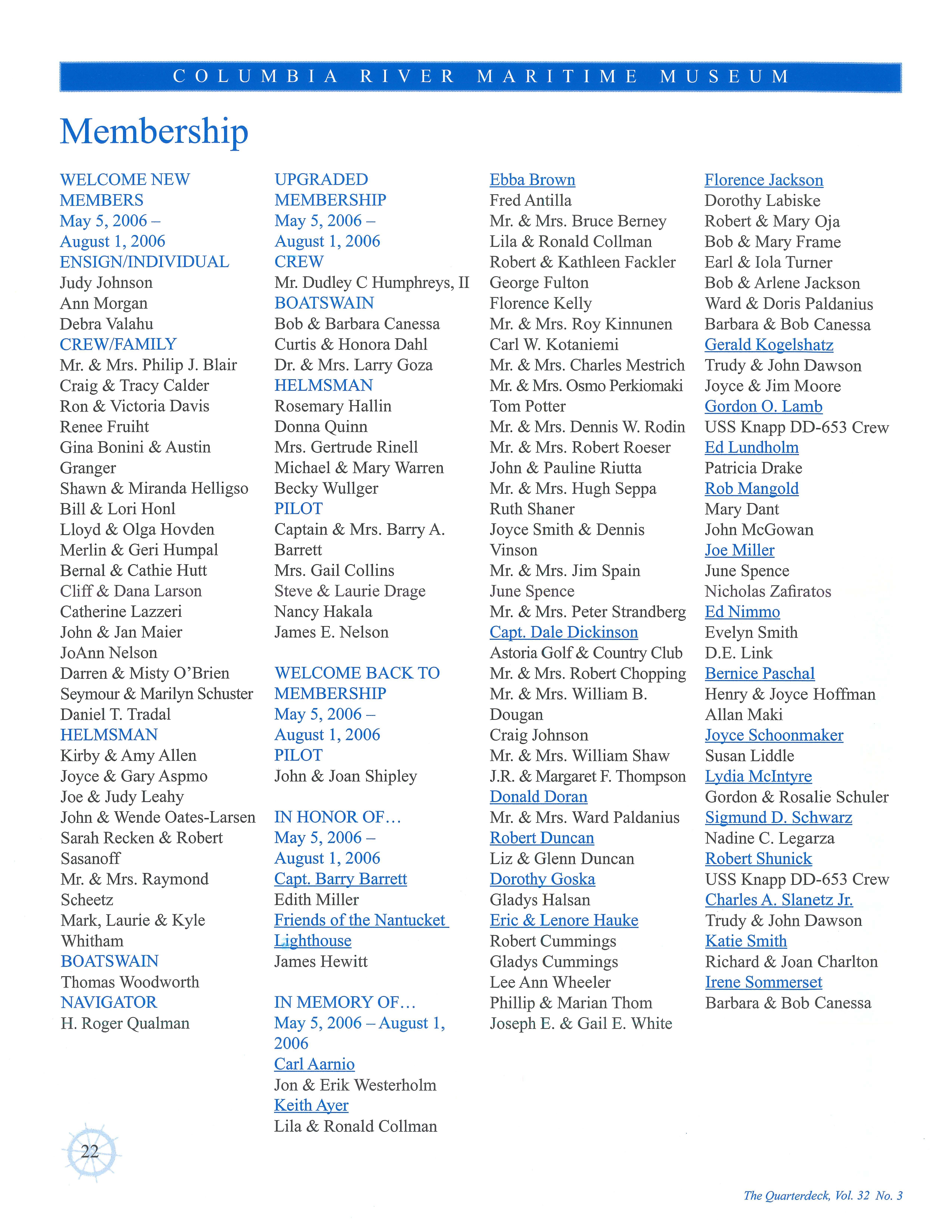
May 5, 2006 May 5, 2006
Mr. & Mrs. Bruce Berney Robert & Mary Oja August 1, 2006 August 1, 2006 Lila & Ronald Collman Bob & Mary Frame
ENSIGN/ INDIVIDUAL CREW
Robert & Kathleen Fackler Earl & Iola Turner Judy Johnson Mr. Dudley C Humphreys, II George Fulton Bob & Arlene Jackson Ann Morgan BOATSWAIN
Florence Kelly Ward & Doris Paldanius Debra Valahu Bob & Barbara Canessa Mr. & Mrs. Roy Kinnunen Barbara & Bob Canessa CREW/ FAMILY Curtis & Honora Dahl Carl W. Kotaniemi Gerald Kogelshatz Mr. & Mrs. Philip J. Blair Dr. & Mrs. Larry Goza Mr. & Mrs. Charles Mestrich Trudy & John Dawson Craig & Tracy Calder HELMSMAN Mr. & Mrs. Osmo Perkiomaki Joyce & Jim Moore Ron & Victoria Davis Rosemary Hallin Tom Potter
Gordon 0. Lamb Renee Fruiht Donna Quinn
Mr. & Mrs. Dennis W. Rodin USS Knapp DD-653 Crew Gina Bonini & Austin Mrs. Gertrude Rinell Mr. & Mrs. Robert Roeser Ed Lundholm Granger Michael & Mary Warren John & Pauline Riutta Patricia Drake Shawn & Miranda Helligso Becky Wullger Mr. & Mrs. Hugh Seppa Rob Mangold Bill & Lori Honl PILOT Ruth Shaner Mary Dant Lloyd & Olga Hovden Captain & Mrs. Barry A. Joyce Smith & Dennis John McGowan Merlin & Geri Humpal Barrett Vinson Joe Miller Bernal & Cathie Hutt Mrs. Gail Collins Mr. & Mrs. Jim Spain June Spence Cliff & Dana Larson Steve & Laurie Drage June Spence Nicholas Zafiratos Catherine Lazzeri Nancy Hakala Mr. & Mrs. Peter Strandberg Ed Nimmo John & Jan Maier James E. Nelson Capt. Dale Dickinson Evelyn Smith JoAnn Nelson Astoria Golf & Country Club D.E. Link Darren & Misty O'Brien WELCOME BACK TO Mr. & Mrs. Robert Chopping Bernice Paschal Seymour & Marilyn Schuster MEMBERSHIP Mr. & Mrs. William B. Henry & Joyce Hoffman Daniel T. Tradal May 5, 2006 Dougan
Allan Maki
HELMSMAN August 1, 2006 Craig Johnson Joyce Schoonmaker Kirby & Amy Allen PILOT Mr. & Mrs. William Shaw Susan Liddle Joyce & Gary Aspmo John & Joan Shipley J.R. & Margaret F. Thompson Lydia McIntyre Joe & Judy Leahy Donald Doran Gordon & Rosalie Schuler John & Wende Oates-Larsen IN HONOR OF Mr. & Mrs. Ward Paldanius Sigmund D. Schwarz Sarah Recken & Robert May 5 , 2006
Robert Duncan Nadine C. Legarza Sasanoff August 1, 2006 Liz & Glenn Duncan Robert Shunick Mr. & Mrs. Raymond Capt. Baro:: Barrett
Dorothy Goska
USS Knapp DD-653 Crew Scheetz Edith Miller
Gladys Halsan
Charles A. Slanetz Jr. Mark, Laurie & Kyle Friends of the Nantucket Eric & Lenore Hauke
Trudy & John Dawson Whitham L i ghthouse
Robert Cummings
Katie Smith
BOATSWAIN James Hewitt
Gladys Cummings
Richard & Joan Charlton Thomas Woodworth
Lee Ann Wheeler Irene Sommerset
NAVIGATOR IN MEMORY OF ... Phillip & Marian Thom
Barbara & Bob Canessa H. Roger Qualman May 5, 2006 August 1, Joseph E. & Gail E. White 2006 CarlAarnio Jon & Erik Westerholm Keith Ayer Lila & Ronald Collman
COLUMBIA RIVER MARITIME MUSEUM
22 Th e Qu arte rdec k, Vol. 32 No 3
Parting Shots
The Peter Iredale continues to fascinate visitors as it has for the last 100 years .
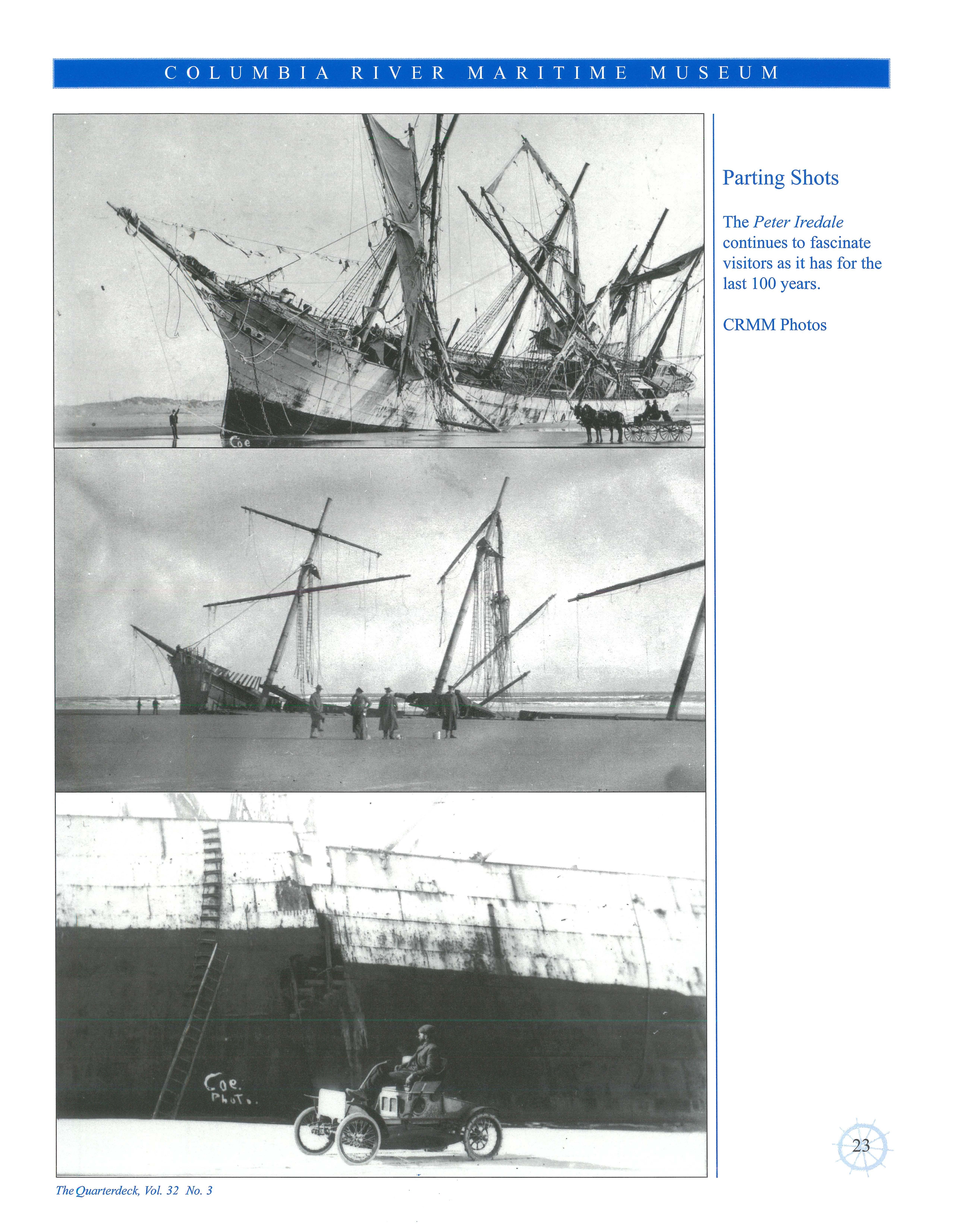
: ____________ ~ () L _ -~--1?-- ~-~- R I __ V ~ ~ __ fv! __ A __ I _! ! ___ M __ ___ M __ ~ ~ !'. -~ -~ __ ________ : The Quarterdeck, Vol. 32 No 3
23
CRMMPhotos
Plan to Join Us At The Cinema
We've reserved1he Asmria Gateway Cinema for our Members to enjoy a special screening of the new film The Guardian. This film brings to life-Hollywood style- the elite training program for Coast Guard Rescue Swimmers. The real Coast Guard Rescue Swimmer School does a large part of its training here in Astoria.
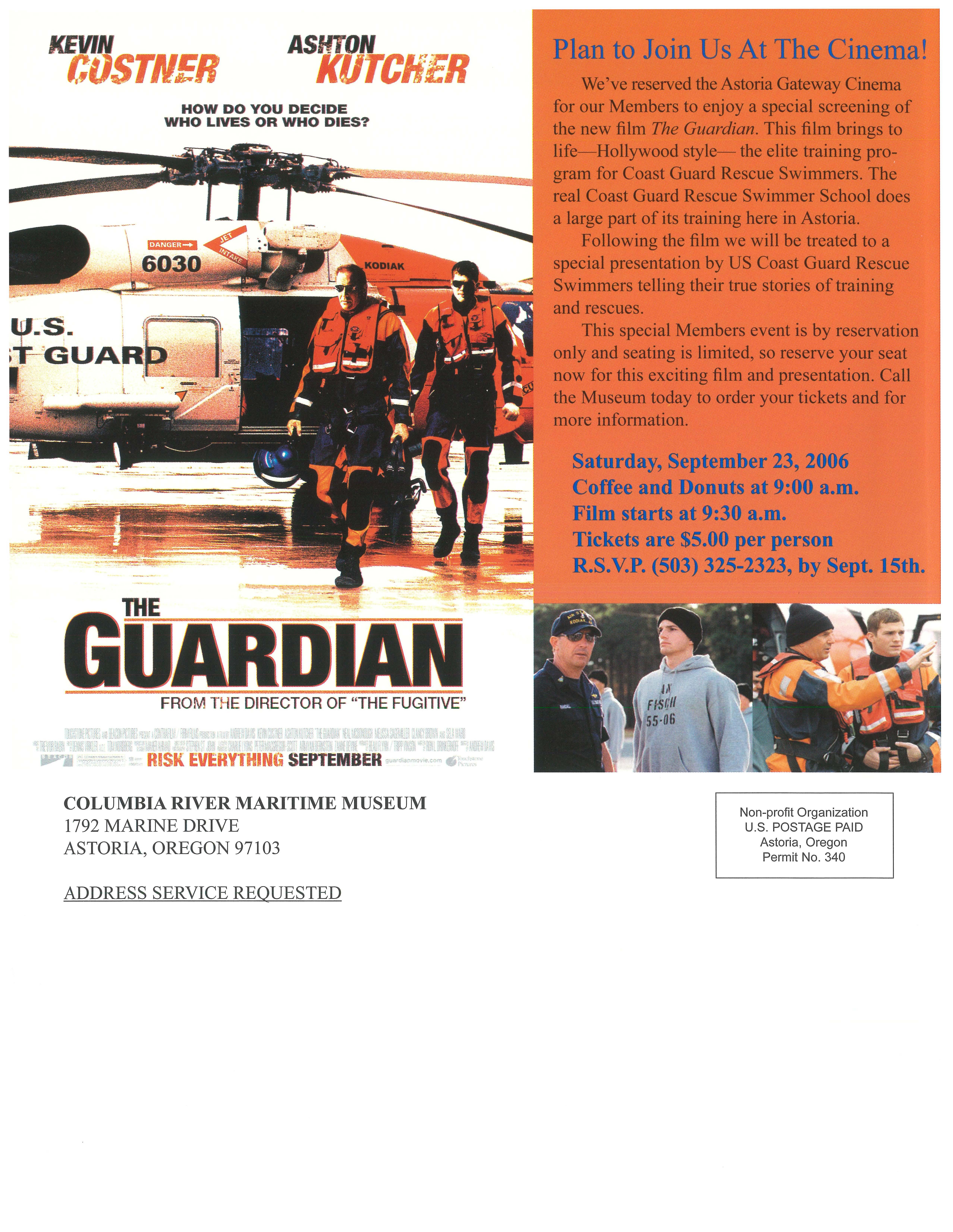
Following the film we will be treated te a special presentation by US Coast Guard Rescue Swimmers telling their true stories of training and rescues.
This special Members event is by reservation 'OGly and is Jin;rlted, so reserve yout,sea,t now for this:~~ fihn and presentation:. Call the Musew:n today to order your tickets and:for more information.
Saturday, September 23, 2006
Coffee and Donuts at 9:00 a.m. Film starts at 9:30 a.m. Tickets are SS.00 per person R.S.V.P. (503) 325-2323, by Sept.15th.
KEVINCOSTNER ASHTON KUTCHER s. ' ,'· UAR · ' ' ) ' _ ; HOW DO YOU DECIDE WHO LIVES OR WHO DIES? GUARD RISK l:'VERYTHING SEPTEMBER COLUMBIA RIVER MARITIME MUSEUM 1792 MARINE DRIVE ASTORIA, OREGON 97103 ADDRESS SERVICE REQUESTED
!
Non-profit Organization U.S. POSTAGE PAID Astoria,
Permit No.
Oregon
340


















 John Porter of P. Iredale & Porter Ltd.
John Porter of P. Iredale & Porter Ltd.



